The Erling-Persson Foundation supports projects within scientific research, tuition and education, and the development of children and young people. The Foundation receives applications from all over Sweden and works continually to drive development forward in its chosen areas.
ANNUAL
2023
REVIEW
Statement by the Chair 4 The Foundation in brief 8 2023 in brief 10 SCIENCE & RESEARCH Joakim Lundeberg, KTH Royal Institute of Technology 14 Anders Kvanta/Fredrik Lanner, Karolinska Institutet 20 Joan Camuñas-Soler, University of Gothenburg 26 Marika Nestor, Karolinska Institutet/Uppsala University 34 Other donations 42 TUITION & EDUCATION House of Innovation 46 Reskilling Ukraine 54 Other donations 58 DEVELOPMENT OF CHILDREN & YOUNG PEOPLE Rätt Kurva (On the right track) 62 Kraftsamling mot utanförskap i Sverige (Joint efforts to counter exclusion in Sweden) 70 Other donations 77 Board of Directors 80 Grants awarded in 2023 82 Financial statements 83 Contact details 84 CONTENTS
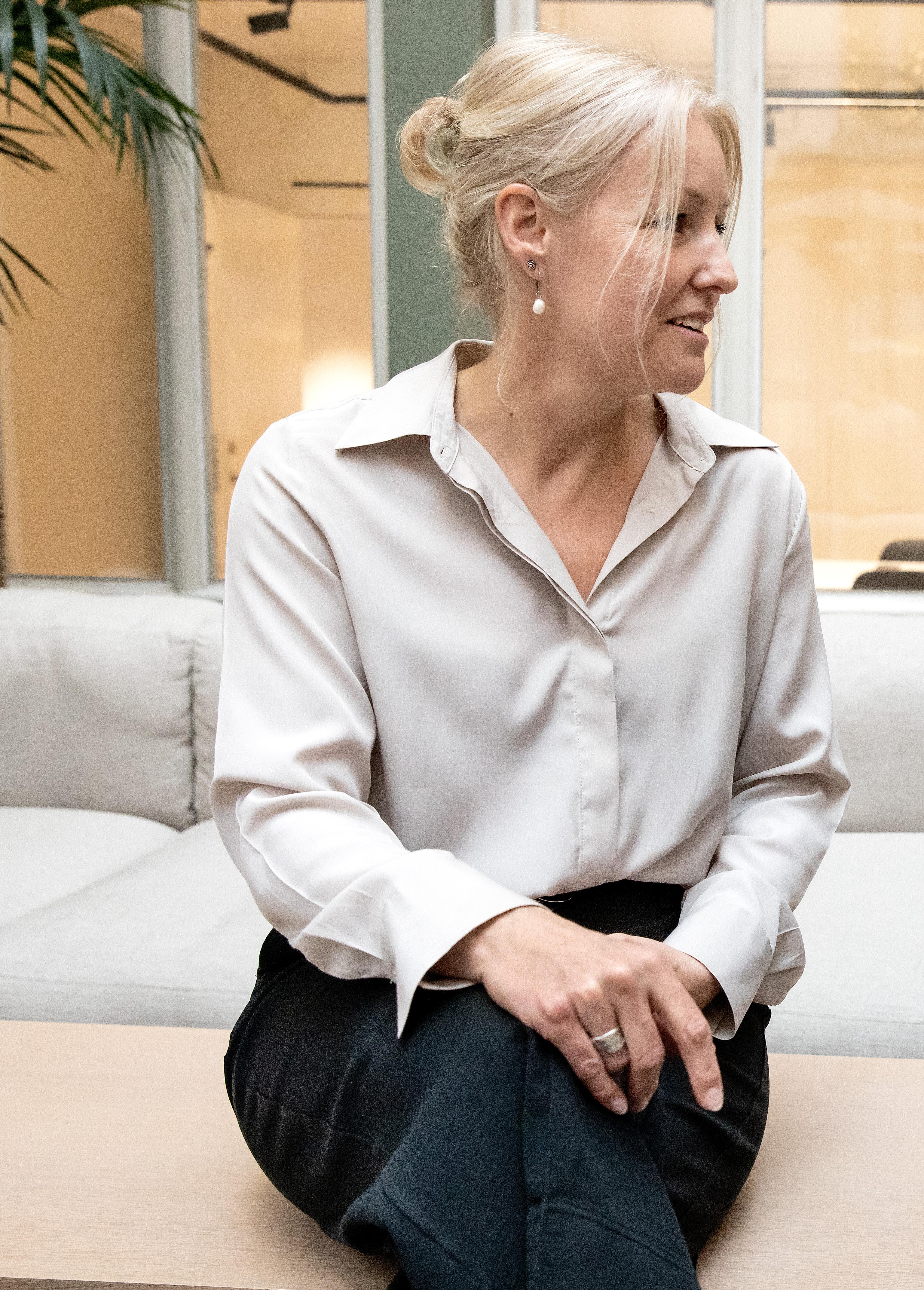 Programme manager Ylva Linderson in conversation with Kristina Stenvinkel, who has responsibility for communications.
Programme manager Ylva Linderson in conversation with Kristina Stenvinkel, who has responsibility for communications.

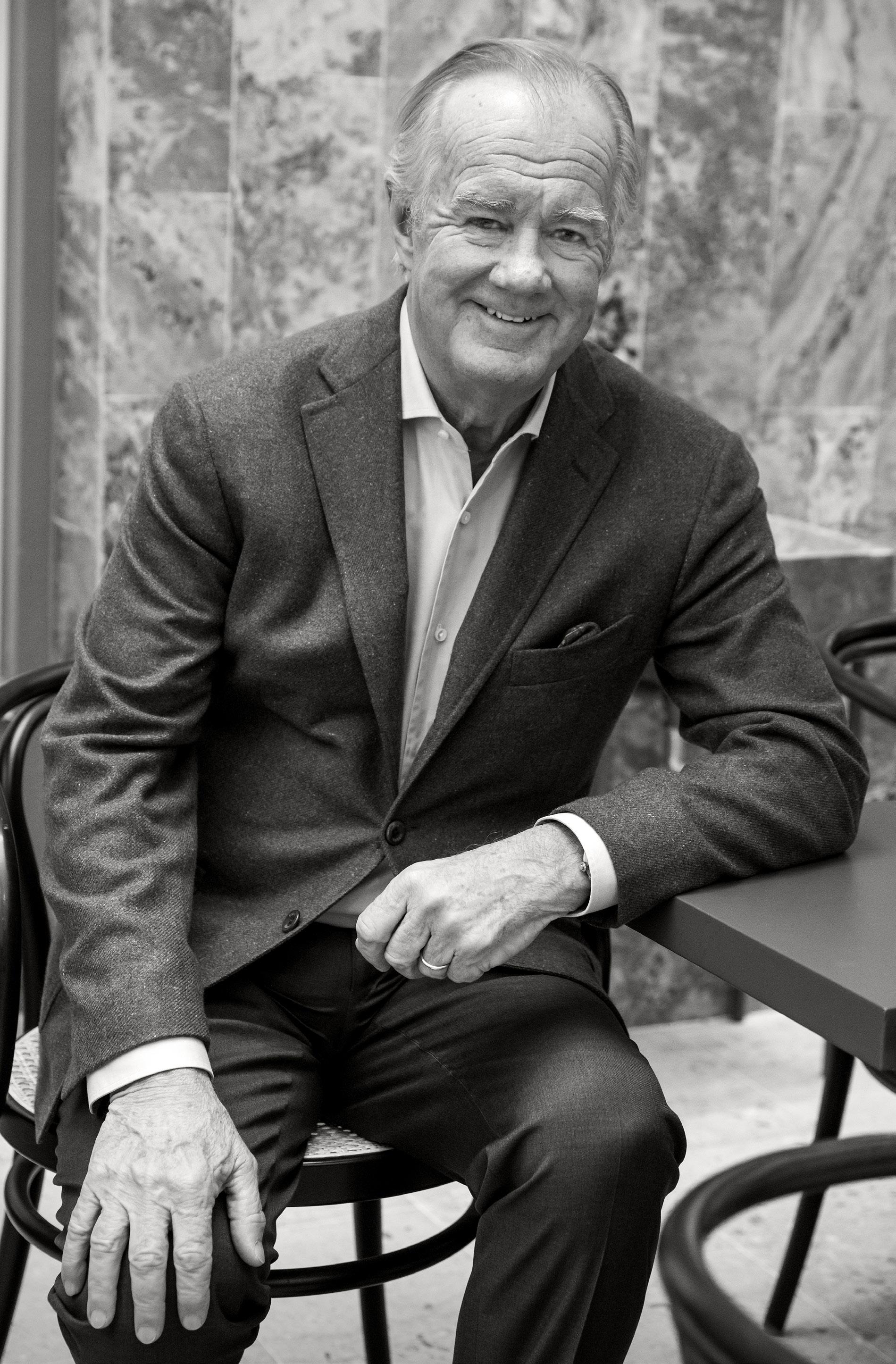
4
STEFAN PERSSON
KNOWLEDGE IS ONE OF OUR MOST IMPORTANT SHARED RESOURCES
The Erling-Persson Foundation has its origin in the Persson family’s interest in entrepreneurship and how entrepreneurship can contribute to real social change.
For nearly a quarter of a century the Erling-Persson Foundation has worked to promote entrepreneurship through education, to give children and young people a good start in life and to push the boundaries of our collective knowledge through research.
The Foundation has its origin in the Persson family’s interest in entrepreneurship and how entrepreneurship can contribute to real social change. Through philanthropic support to our selected focus areas we hope to contribute to society’s development in further ways. The Foundation’s work also gives us as a family an opportunity to come together in our community engagement and in our firm belief that knowledge is one of our most important shared resources. Our focus areas also reflect themes that are particularly close to the family’s heart.
Over the past year various initiatives to promote entrepreneurship have received support. Stockholm School of Economics (SSE) was granted SEK 467 million for the long-term development of House of Innovation, its specialist environment for innovation, digitalisation and entrepreneurship. This support is the largest amount that the Foundation has given to the School and is also the largest individual donation that SSE has ever received. Research into entrepreneurship in companies operated at Hanken School of Economics in Helsinki, Finland also received support, while Ung Företagsamhet (Junior Achievement Sweden) received grants to broaden its operations for primary and secondary school pupils.
By supporting researchers at Swedish seats of learning, the Foundation hopes to contribute
to increased knowledge that makes a difference to people’s health. Over the year recently ended SEK 138 million was given in support of Swedish research, including to projects aimed at producing new potential treatments for cancer, rapid diagnosis of bacterial infections in the blood and for mapping the underlying causes of rare diagnoses in children, to mention just a few. This Annual Review reports in more detail on some of the projects that have received support.
It cannot have escaped anyone that gang crime is an increasing threat at many levels in our society, and that it is creating growing concern as regards our children and young people. As part of Rätt Kurva (On the right track), a new partnership between public and private sector actors, the Foundation wants to contribute to more young people finding their way away from destructive life choices. By supporting the activities of SOS Children’s Villages in Sweden, the Foundation hopes to contribute further to vulnerable young people getting the support they need to get on the right track. Guiding all young people towards secure lives is no small task. There is no universal solution, but with joint efforts we believe we can bring about change.
For two years now a war has been raging on the eastern edge of Europe, leaving behind enormous needs for support and assistance. In the initial stages of the war humanitarian aid for displaced people was high on the agenda. At that time the Foundation chose to support the Red Cross and Save the Children, which each received SEK 125 million for their efforts in Ukraine. The need for humanitarian aid remains, but in parallel efforts are underway to strengthen the
5
country and its population in order to assist with the reconstruction that has already begun. In the Reskilling Ukraine project, women who have lost their livelihoods due to the war have the opportunity to retrain for professions where there is currently a shortage of labour.
There is no answer to how long a war will last or how long it will take to reverse the trend in Swedish criminality. Nor does anyone know when we will be able to cure all cancer or solve the energy issue. However, as a charitable foundation we can play a part in building a good and sustainable society in both the short and long term. We tell you more about some of these contributions in this Annual Review.
Stefan Persson Chair of the Board
6
“It
cannot have escaped anyone that gang crime is an increasing threat at many levels in our society, and that it is creating growing concern as regards our children and young people. As part of Rätt Kurva, a new partnership between public and private sector actors, the Foundation wants to contribute to more young people finding their way away from destructive life choices.”
7
STEFAN PERSSON
THE FOUNDATION IN BRIEF
THE FOUNDATION’S ORIGIN AND PURPOSE
Since the Erling-Persson Foundation was formed in 1999 it has made more than 300 donations totalling SEK 5.4 billion. The long list of recipients includes Karolinska Institutet, Stockholm School of Economics and Fryshuset.
In 1947 Erling Persson established the company that has developed into the global H&M Group we know today. The Erling-Persson Foundation was formed in 1999, in memory of his many achievements in retail and enterprise, financed by donations from the Persson family.
The family is passionate about entrepreneurship as a positive force in society, so supporting education in this area was a natural initial focus area for the Foundation. Before long two more focus areas were added, aimed at equipping society better for the future: support for research and support for the development of children and young people.
The Foundation sees meetings and collaboration as important for stimulating new thinking and new solutions. It is therefore pleased to support interdisciplinary ventures and projects that link together different sectors of society.
The Foundation’s commitment to the projects it supports is based on confidence that the project owner has the capability to expand the boundaries of our shared knowledge and understanding, as well as a sure and certain belief that knowledge changes and improves lives. More than 300 donations have been made to date, with the Foundation having given SEK 5.4 billion to causes that benefit society.
The largest single donation so far, SEK 600 million, was made to the Nobel Center Foundation in 2022. The donation will enable the construction of the new Nobel Center at Slussen in Stockholm. Along with its contents, the building will inform, inspire and stimulate.
Various entrepreneurship courses have together received around SEK 1.3 billion, with Stockholm School of Economics, Stockholm School of Entrepreneurship and the Royal Swedish Academy of Engineering Sciences (IVA) major recipients. A donation of SEK 75 million from the Foundation also enabled the start of education and research in a new subject: fashion studies. The Centre for Fashion Studies is now well established at Stockholm University.
In the scientific field, research into type 1 diabetes is the area where the Foundation has made its largest contribution, amounting to around SEK 400 million to date. Significant support has also been given to research in areas such as cancer, cardiovascular disease, antibiotic resistance and neurological disease.
Fryshuset was the first children’s and young people’s organisation to receive support from the Foundation for its activities. So far, its projects have received funding from the Foundation totalling around SEK 195 million, helping Fryshuset to develop into a highly valued centre for children and young people within sport, knowledge, leisure activities and more. Organisations for children and young people have together received around SEK 560 million.
At the end of 2023 donations to the three focus areas were distributed approximately as follows: 45 percent to research, 45 percent to education and 10 percent to children and young people.
8
250
The largest donations to date of a humanitarian nature were awarded in conjunction with the fullscale invasion of Ukraine. In 2022 the Red Cross and Save the Children each received SEK 125 million in support for their efforts for people affected by the war.
2 in 5
Applications for support for research are received from all over Sweden. Just over 40 percent of all main applicants are women.
1999
Erling Persson established the company that has developed into the global H&M Group we know today. In 1999 the Erling-Persson Foundation was formed in memory of his many achievements within retail and enterprise.
4
The Foundation’s board holds its regular meetings four times a year.
75
In 2006 the Centre for Fashion Studies was established at Stockholm University, aided bya donation from the Foundation (totalling SEK 75 million). Since 2018 fashion studies has been an independent academic discipline at the university.
5.4
Since the Foundation was formed in 1999 it has handed out more than SEK 5.4 billion to its three focus areas.
138.5
Education and research in the areas of climate and the environment are important for being able to build a sustainable future. Through various initiatives the Foundation has donated SEK 138.5 million to these areas.
2.5
Over the years around SEK 2.5 billion has been awarded in the area of Tuition & Education, representing around 45 percent of all funds donated.
560
By 31 December 2023 the Foundation had granted funding to 82 projects that promote the development of children and young people, amounting to SEK 560 million in total.
45%
Just under half of the total funds distributed by the Foundation, or SEK 2 billion, has been awarded to research projects led by Swedish universities and colleges.
400
A donation of around SEK 400 million was made to Karolinska Institutetin 2010 and enabled the building of the Aula Medica, a 10,000 square metre complex serving the needs of research and education.
150
The Foundation receives more than 150 applications forproject support every year. Around 100 of these are research applications.
9
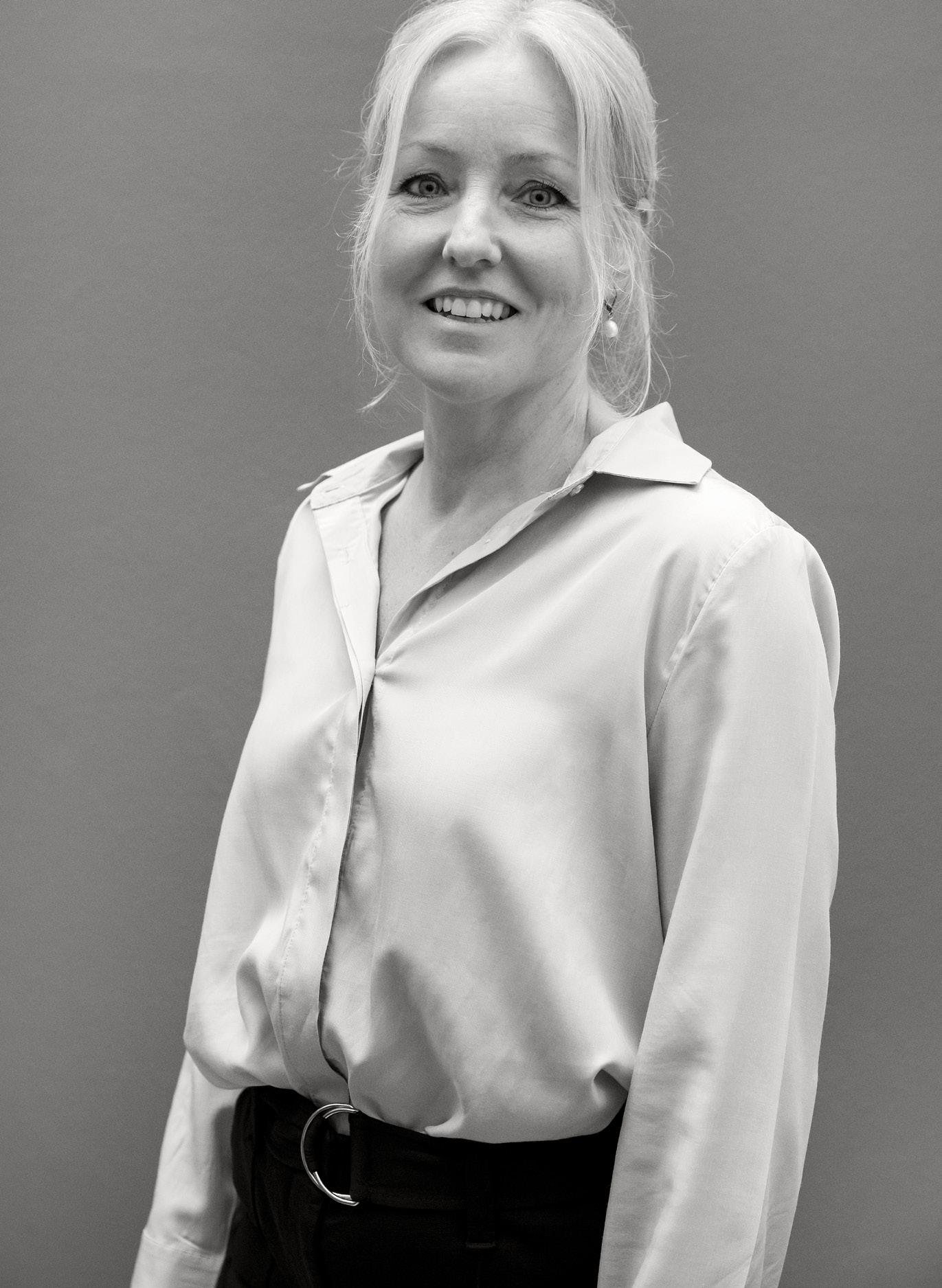
10
2023 IN BRIEF
In 2023 the Erling-Persson Foundation received many interesting and important project proposals. At the end of the year programme manager Ylva Linderson added up the donations at SEK 770 million across 26 projects within the Foundation’s three focus areas.
When people are asked about their views on society’s development, right now many say that everything is heading in the wrong direction. It does not take much imagination to understand why. There are plenty of reasons, both in Sweden and in the wider world. In many ways, being able to devote your time to the activities of a charitable foundation provides a counterbalance to this picture. Every day we see people working hard to solve problems, to reverse trends and to inspire others. The numerous initiatives we have the privilege of being part of through the Foundation are united by an unwavering desire to benefit people and society. This desire is found in all parts of society: in civil society, in the business sector and in the public sector alike.
In 2023 the Erling-Persson Foundation donated SEK 770 million to causes in its focus areas. In the area of science and research, 10 projects were awarded a total of SEK 138.5 million. As well as projects addressing the development of new potential cancer treatments, problems such as sepsis, rare diagnoses in children and the mapping of cell functions at a detailed level were also explored with the support of the Foundation. Atlas of Childhood Disease is the individual research project to which the Foundation donated the most funds in 2023 (SEK 65 million). In this project, which is a collaboration between several research groups, the aim is to understand how congenital diseases – for example, in the brain, heart and lungs – arise in children.
Eight organisations working for the development of children and young people shared SEK 62.6 million in 2023. The various projects aim to counteract the negative consequences of various forms of vulnerability,
lower the thresholds for young people to find meaningful leisure activities and guide young people on their path to education and careers. Rätt Kurva (On the right track) is a unique project in which the police, social services, schools and the business sector are collaborating to offer initiatives for children at risk of criminality, based on the child’s individual interests and abilities, in order to build the child’s motivation and resilience. SOS Children’s Villages Sweden focuses particularly on support for young people leaving social care but also aims to support adults in their parenting role.
Support for Tuition & Education amounted to SEK 568 million over the past year, of which SEK 467 million was donated to House of Innovation at Stockholm School of Economics. The conditions for young leadership were strengthened by the Foundation’s support for a new professorship in the subject and its support for the Young Academy of Sweden. In this Annual Review we also talk about a special training initiative, Reskilling Ukraine, which gives women in Ukraine the opportunity to retrain in professions for which there is currently a shortage of labour due to the war.
The projects in the stories that we get to be involved in have very different purposes, but what they all have in common is that they are driven by individuals who are extremely knowledgeable in their field and who have strong convictions and a desire to improve people’s lives. As a result, it feels like there are things in our world that are actually moving in the right direction.
Ylva Linderson Programme Manager
THE PAST YEAR 11
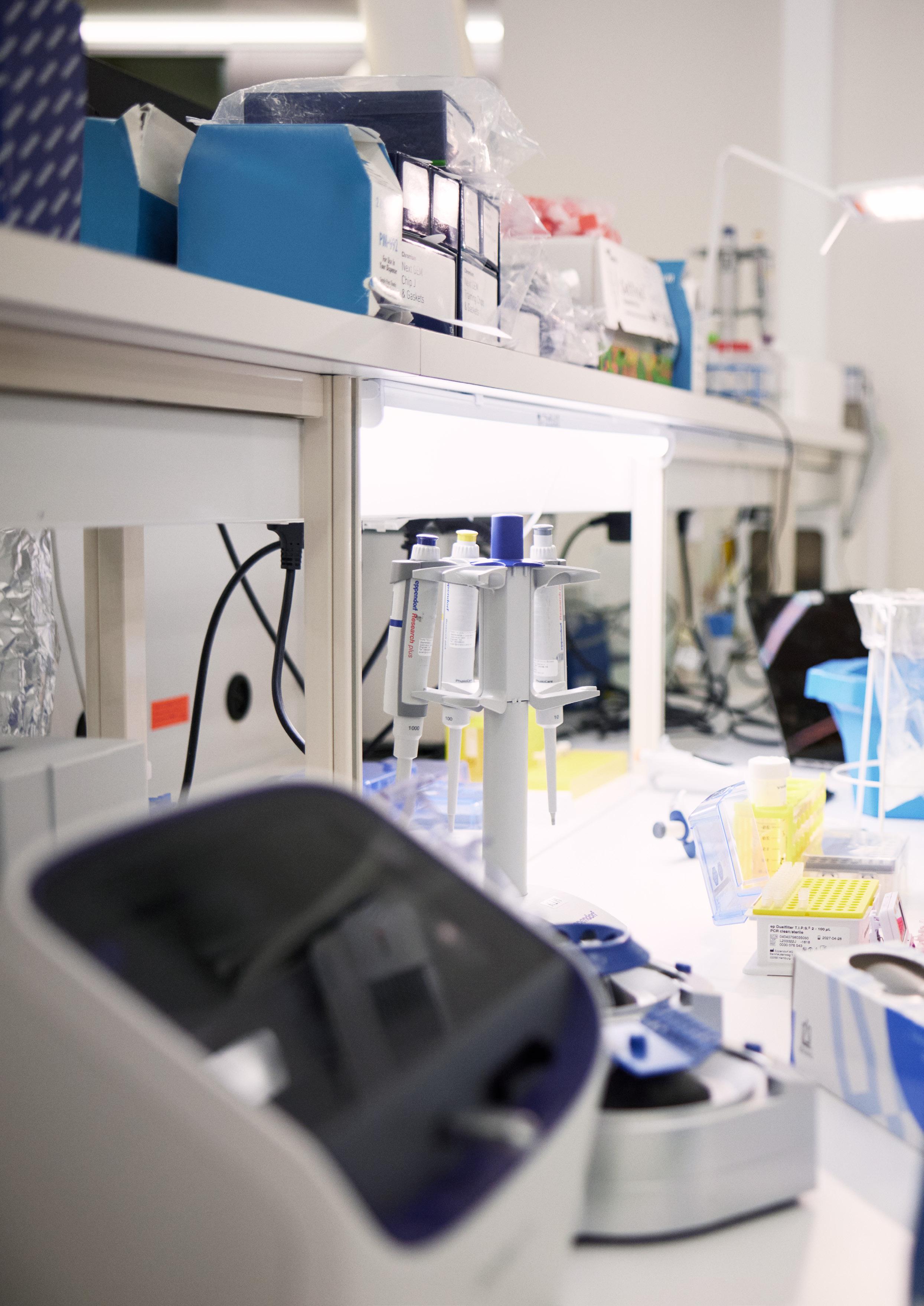
Science &
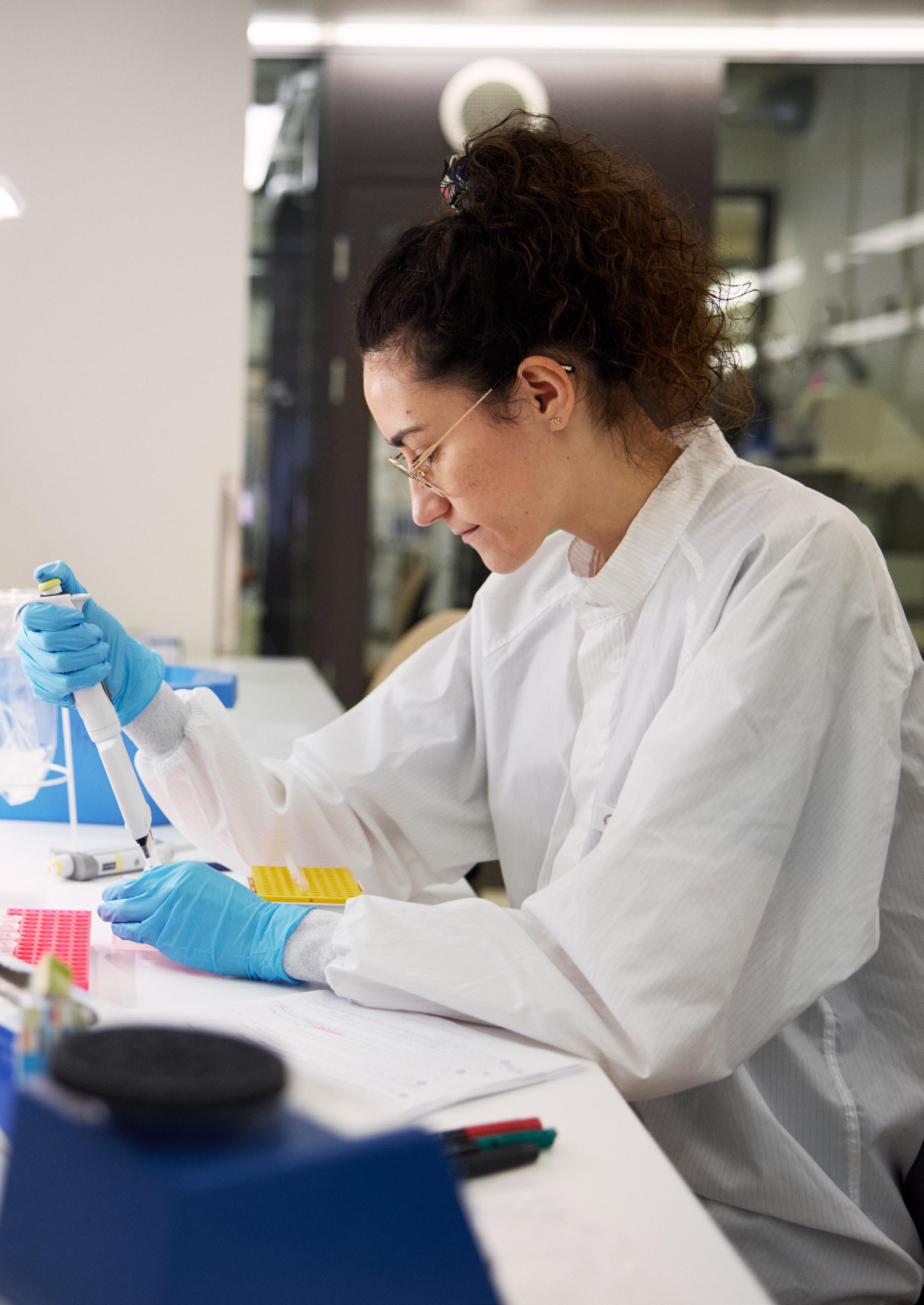
Research
SEK 65.5 M / 5 YEARS
AIM: TO UNDERSTAND HOW DISEASES ARISE IN CHILDREN
In an ambitious project researchers are aiming to investigate how congenital diseases – such as those affecting the brain, heart, and lungs – arise in children. Building on the new knowledge generated, the next step will be to explore possibilities for developing new treatments.
The convergence of genetics and environment means that around three percent of all children are born with some form of congenital condition. The Atlas of Childhood Disease project focuses on these disorders, following on from the work achieved in a previous international collaboration known as the Human Development Cell Atlas. This consortium’s goal was to create a cell atlas of the cells forming various organs in a healthy individual during early development.
Swedish researchers analysed over a million brain cells from 27 early embryos, identifying more than 600 different cell types – as published in Science. They also mapped the development of the heart, with results published in Cell and elsewhere. The cells forming the early lung and spinal cord were also published, in Nature Medicine and Nature Neuroscience respectively.
In the Atlas of Childhood Disease researchers from Karolinska Institutet, KTH Royal Institute of Technology and Stockholm University are building further on the data collected, supplemented with new data, with a clear focus on understanding how disorders arise in children.
The first part of the project focuses on studying rare congenital disorders affecting the brain, heart and lungs. Disorders resulting from the improper development of cilia – which are cell protrusions resembling antennae – are also being studied. For this, the researchers utilise genetic and tissue samples. Clinical samples from children with genetic disorders will be compared with the researchers’ existing cell atlas of normal organ development. Differences
observed in the samples can then be linked to new suspected risk genes.
In the second part of the project the focus is on brain tumours in children, the deadliest form of cancer in this age group and the second most common after leukaemia. Patient samples are analysed using techniques that reveal which genes are active in the cells forming the tumours, but also how tumour cells interact with surrounding immune cells. The aim is to identify differences between tumour cells and healthy brain cells to identify potential targets for treatment.
“The aim is to identify differences between tumour cells and healthy brain cells, to identify potential targets for treatment.”
In a third part of the project the researchers are attempting to create nanoparticles filled with DNA targeted at specific sites on tumour cells. These nanoparticles are encapsulated in lipids, allowing them to deliver their payload of corrective genetic material to the target organ, potentially leading to new drugs. All three subprojects have been under way in parallel since 2023.
In Joakim Lundeberg’s research group at the Department of Gene Technology at KTH Royal Institute of Technology, located at the Science for Life Laboratory (SciLifeLab), physician and senior researcher Enikö Lazar has taken on the role of scientific coordinator.
14
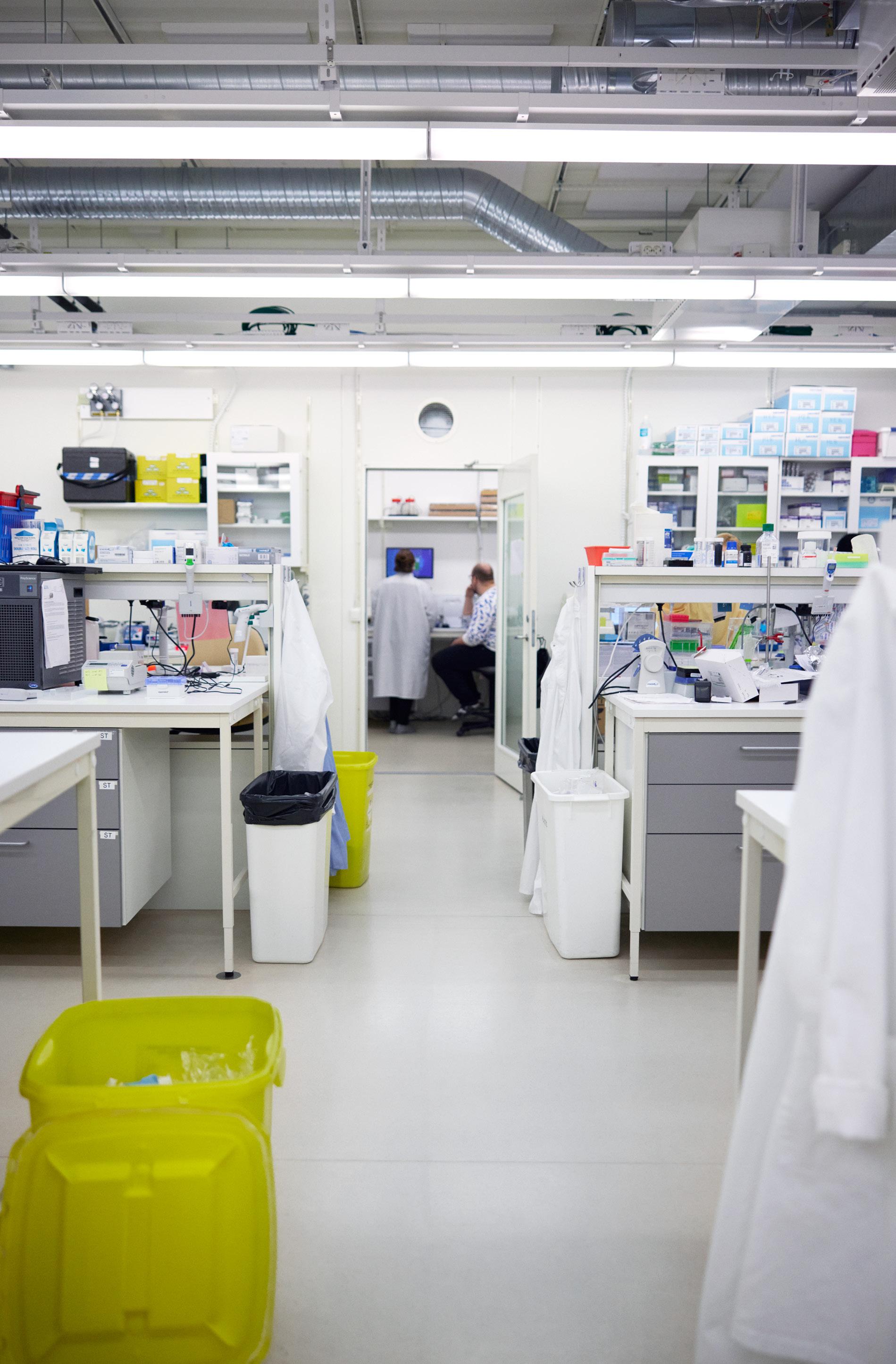
The research leads’ laboratories have different specialities that complement each other. Some work on technology development, others on various organ systems or specific diseases.
15
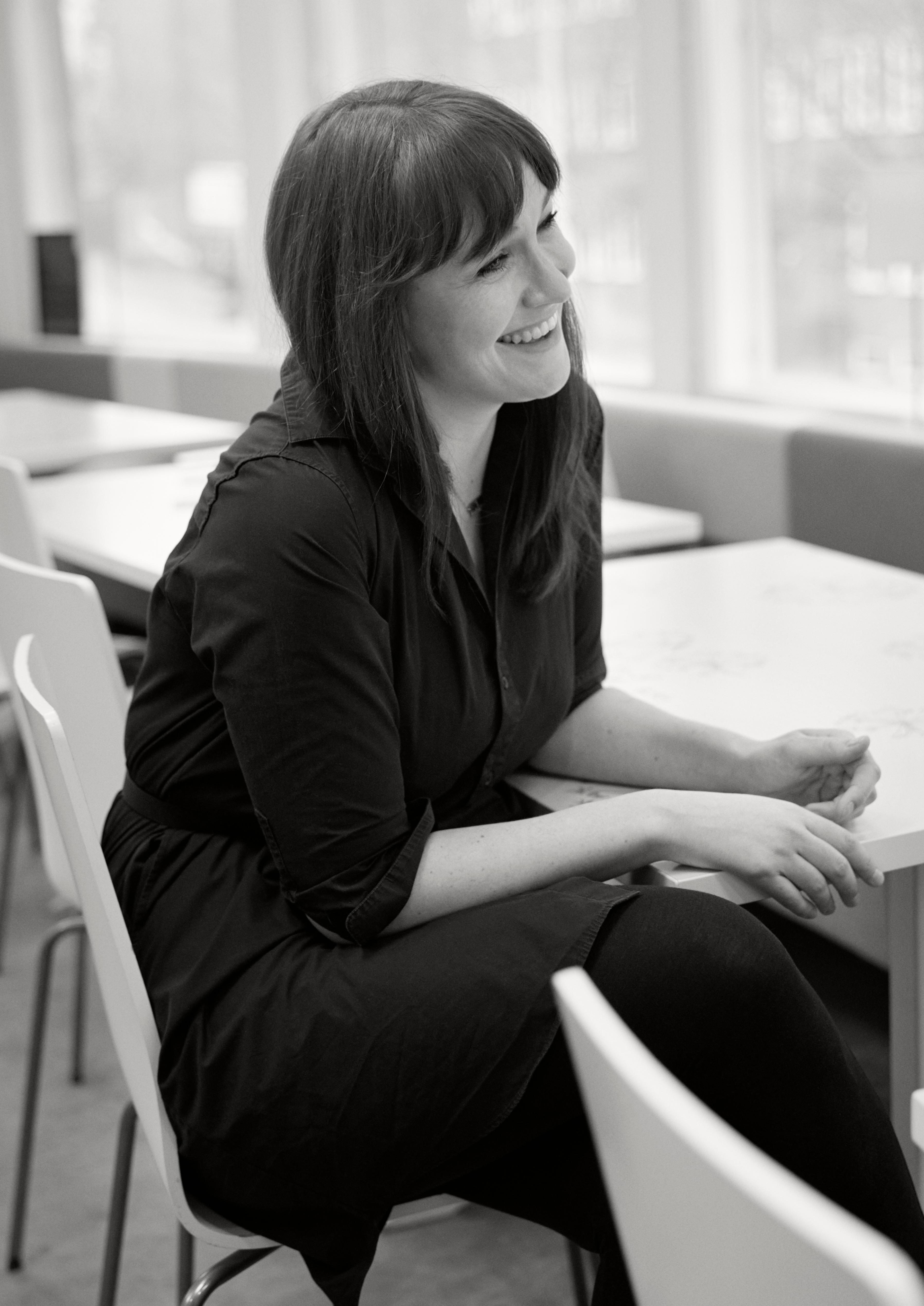
Enikö Lazar highlights the clinical research leads. “In the previous atlas project we focused on normal development, but now we can link this data to how things can go wrong later in life – which is where their clinical perspective is crucial.”
“I organise the meetings with research leads as well as with younger researchers on the project,” she says.
She points out how the specialities of the various research leads complement each other. Joakim Lundeberg focuses on technology development, for example, while Christos Samakovlis works on the lung. Erik Sundström is interested in spinal cord tumours and Emma Lundberg works on cilia.
“Cilia in particular are incredibly important for the correct development of all the organs during embryonic development and for ensuring that all the structures in the body end up in the right place,” says Enikö Lazar.
Today 35 different disorders – known as ciliopathies – can be linked to faulty cilia development.
In the previous atlas project she mapped cells during heart development. Analysing around 80,000 cells in the developed heart made it possible to identify small but highly specialised cell populations, both cells forming parts of the heart valves and cells responsible for regulating heart rhythm.
“In the upcoming project we will use this insight to analyse heart samples with structural defects, in order to understand which cell types and molecules are behind these disorders,” she says.
One new element is that clinical research leads are also involved in the project.
“In the previous atlas project we focused on normal development, but now we can link this data to how things can go wrong later in life – which is where their clinical perspective is crucial,” says Enikö Lazar.
Mats Nilsson, a professor of molecular biology at the Department of Biochemistry and Biophysics at Stockholm University, also works at SciLifeLab.
“My piece of the puzzle in this project is technology development, particularly a technique called in situ sequencing,” he says.
In brief, this involves analysing the cells within a tissue section very precisely, allowing researchers to see which genes are active in a particular cell at that moment – potentially hundreds of different genes. These activity patterns reveal both the cell’s identity and its communication with other cells.
“What tends to get people’s attention is that in our sections we can analyse hundreds of thousands of cells in a single experiment, so it quickly adds up to millions of cells. Our contribution is that we can add a spatial dimension, to see where in the tissue the cells are active,” he says.
He will contribute to various parts of the project, but ever since his doctoral studies he has had a special interest in the part focusing on brain tumours.
“Thirty years ago the technology was nowhere near developed enough, but I realised that to understand tumours you need to be familiar with their entire cellular organisation,” he says.
In this project he hopes that new technology will make it possible to understand disorders on a deeper level than has been possible with techniques that only analyse one cell at a time.
“We are very good at curing cancer in cells in petri dishes or in lab mice, but moving a treatment on to humans has proved to be a very long step. It is my hope and belief that we will have a chance of doing that now that we don’t need to separate and analyse individual cells, but instead can take a systemic perspective and examine how they interact with each other,” says Mats Nilsson.
“What tends to get people’s attention is that in our sections we can analyse hundreds of thousands of cells in a single experiment.”
Sten Linnarsson, a professor of molecular systems biology at the Department of Medical Biochemistry and Biophysics at Karolinska Institutet, focused on the brain in the previous atlas project.
“We found around 3,300 different cell types in an adult brain, with the greatest diversity in the brainstem. Mapping is like a census; you need a sufficiently large sample to get a good picture,” he says.
Now he focuses on brain tumours in children, where the prognosis for some forms is very poor. It has been that way for a long time, he says.
“I have a book from 1923 that describes glioblastoma, showing tables of patients and their survival rates, which were 12 months on average. A hundred years on the picture is exactly the same today, which is depressing,” he says.
His group has been able to show that tumours in adults and children resemble how the brain looks during its early embryonic development.
“This means that tumours, specifically, contain particular transcription factors and molecules that are no longer present in the rest of the more developed brain. This could be a hook to use when fishing for targets in the tumours,” says Sten Linnarsson, continuing:
“It’s still expensive, and progress is slow, but for the first time we can look into the tumour and into the brain in a way that is starting to become complete.
17
In addition, a huge revolution is taking place in our ability to manipulate cells and, for example, our ability to introduce DNA or RNA using nanoparticles. Although there’s still a long way to go, I can see that it must be possible to make progress by this route – I cannot believe that brain cancer will never be curable.”
Anna Wedell, a professor in the Department of Molecular Medicine and Surgery at Karolinska Institutet and a senior physician at the Centre for Congenital Metabolic Diseases at Karolinska University Hospital, is one of the project’s two clinical research leads. Her research focus is rare hereditary diseases.
“Of the organs being analysed in the project it is the brain that interests me, because my diagnostic activities – both clinical and scientific – deal with rare diseases that often affect the brain,” she says.
A full 16,000 patient samples have been sequenced for diagnostic purposes in respect of the patient’s entire genome. In terms of rare congenital genetic disorders, around 7,000 are known today. Most affect the brain, for example by causing symptoms such as epilepsy that can arise when patients are still infants. For epilepsy specifically, her group has collected material from 750 families, including blood samples from both parents and the affected child. She envisions the new atlas project as contributing to better understanding.
“We have a huge number of genes and we know that certain mutations cause disorders, yet we know very little about what those genes do. It’s about starting to piece that puzzle together and seeing, for example, that it seems to be more dangerous to have a particular mutation if it is expressed in, say, astrocytes, rather than in neurons. At the moment we still know very little about which cell types are involved and how neurons rely on support cells. When we talk about epilepsy, people tend to just say epilepsy – but my interpretation is that there are lots of different variants,” says Anna Wedell.
One matter to be investigated is whether specific cells, or perhaps cell stages, that exist only during embryonic development but are hidden in the child’s finished brain may be of significance in the development of disorders.
“That’s a really exciting area. One could conceivably investigate which genes are expressed there and see how these genes then appear in our patients, and perhaps be able to connect certain mutations to the disorder,” she says.
She hopes that the atlas project will ultimately make a clinical contribution to a better understanding of disease mechanisms.
“In an atlas we describe things, but the next step is
harder – understanding function based on that. These rare disorders are a good starting point for doing that,” she says, continuing:
“As we’re beginning to get genomic data from lots of patients, some have mutations in known genes and then we can make a diagnosis. But we have a lot of suspect genes that don’t qualify as being a diagnosis. We can then start investigating whether they resemble the known genes in their expression patterns and how they behave. If this substantiates their having a function, we can move forward with them and use animal models to confirm that they are indeed responsible.”
All four emphasise the importance of support from the Erling-Persson Foundation. Anna Wedell particularly highlights the importance of receiving this support over a lengthy period.
“It is absolutely crucial to have this type of longterm substantial support so that we can carry out multidisciplinary work. It’s much more than just a project grant – after all, we’re building an environment where it’s hugely important to be able to bring together everyone’s expertise,” she says.
Mats Nilsson agrees.
“The large grants that the Erling-Persson Foundation can provide are incredibly important. They enable us to gather together a critical mass of researchers, so that we can perform the ambitious experiments needed,” he says.
Enikö Lazar points out that although the project requires expensive technology and reagents, the focus is on the employees.
“The grant is especially important for young researchers. For them, the project provides the opportunity to create new networks and allows their work to contribute to important research results,” she says.
Sten Linnarsson emphasises the importance of bringing knowledgeable employees from other disciplines into the project.
“Working together with the surgeons and pathologists who take care of the patients and help us obtain the tissue samples that we are entirely dependent on is fundamental,” he says.
18
FACTS / BUILDING ON THE ATLAS PROJECT SUPPORTED PREVIOUSLY
The current project is partly based on the Human Development Cell Atlas (HDCA) consortium project, which created atlases of the cells that make up different organs. These atlases are freely available for other researchers to use.
100,000
The number of cells in a tissue section that researchers can analyse in a single experiment using in situ sequencing.
12
The number of months a person with glioblastoma – a type of brain cancer – survived on average in 1923. It is still the same today, which shows the importance of finding new treatments.
ABOUT THE PROJECT
7,000
The estimated number of rare disorders that exist, with most affecting the brain; for example, by causing epilepsy.
Project leads: Joakim Lundeberg, Sten Linnarsson, Emma Lundberg, Mats Nilsson, Christos Samakovlis, Erik Sundström, Anna Wedell and Anna Lindstrand.
Title: Atlas of Childhood Disease.
What it involves: Taking a three-step approach, the aim is to compare clinical samples – both tissue and sequenced genomes – from children with rare genetic disorders against an existing cell atlasof normally developed organs, in order to identify possible risk genes. Diseases affecting the brain, heart and lungs as well as those caused by incorrect development of cell cilia arbeing investigated. The second part of the project focuses on brain tumours in children. In a third part, the goal is to develop a new type of treatment using nanoparticles.
Funding: The Erling-Persson Foundation is supporting the project with SEK 65.5 million over five years.
19
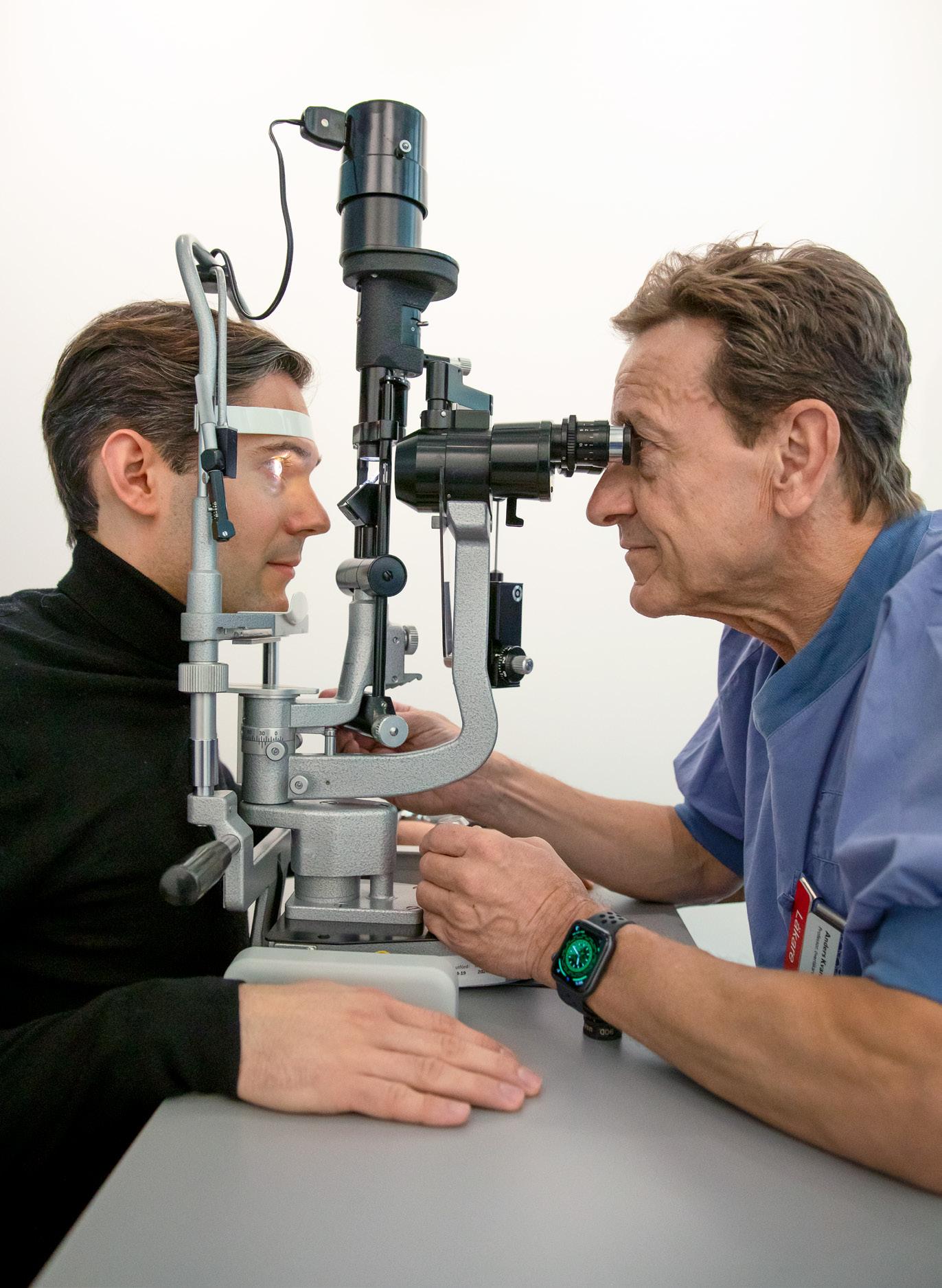
20
A NEW WAY TO TREAT BLINDNESS USING MODIFIED STEM CELLS
Many people experience deteriorating eyesight with age, and more than 100,000 Swedes live with such vision impairment due to the death of cells in the macula. Anders Kvanta and Fredrik Lanner are now to provide patients with healthy replacement cells grown from stem cells.
In the middle of the eye’s retina is a millimetre-sized area called the macula, where cones are densely packed. Cones are the photoreceptors that detect colours and enable us to see sharply. In dry macular degeneration the support cells that cones need – the retinal pigment epithelium (RPE) – die, creating areas without cones.
Anders Kvanta, professor of ophthalmology and senior physician at St. Erik Eye Hospital, Karolinska University Hospital in Solna, describes how the surface of dead cells appears to darken when using an imaging technique called fundus autofluorescence.
“The area without cells turns black and the eroded areas resemble a map in contrast to areas with healthy cells that remain light,” he says.
“Our dream is not only to slow the rate of deterioration, but in the future to also be able to recover lost sight.”
In Sweden 1,500 people are diagnosed with dry macular degeneration every year and more than 100,000 people live with the disease, which gradually but relentlessly destroys their vision.
For more than 10 years Anders Kvanta has collaborated with stem cell researcher Fredrik Lanner, a senior researcher at the Department of Clinical Science, Intervention and Technology at Karolinska Institutet in Huddinge.
“I was previously most interested in understanding how embryonic stem cells develop, but our
collaboration has shown me how we can use stem cells to actually treat people and possibly cure a serious eye disease,” he says.
In the project A first-in-human clinical trial on embryonic stem cell-derived retinal cells for macular degeneration patients will be treated using a completely new method, which involves providing them with new and healthy cells in their damaged eye.
The researchers explain that it has long been said that there is no treatment for dry macular degeneration, something that today is partly true. This is because in the USA there is an approved drug that slows the progression of the disease, as demonstrated by slower growth of the area with dead cells in the eye.
“But there is no connection to improving visual function. Nor is the drug approved in Europe,” says Anders Kvanta, continuing:
“Our dream is not only to slow the rate of deterioration, but in the future to also be able to recover lost sight.”
The upcoming clinical trial will primarily test the safety of the new method, however.
“Of course we hope it will be effective, but we cannot count on it at this stage,” he says.
Going from cultivating a specific type of cell from stem cells to being able to use these clinically is a lengthy process. In an important study along the way, the researchers tried injecting a suspension of the developed retinal pigment cells under the retina of rabbits, whose eyes are similar in size to ours. “The cells formed a fine layer exactly as we want them to, without any clumps,” says Anders Kvanta.
SEK 10 M / 3 YEARS
21
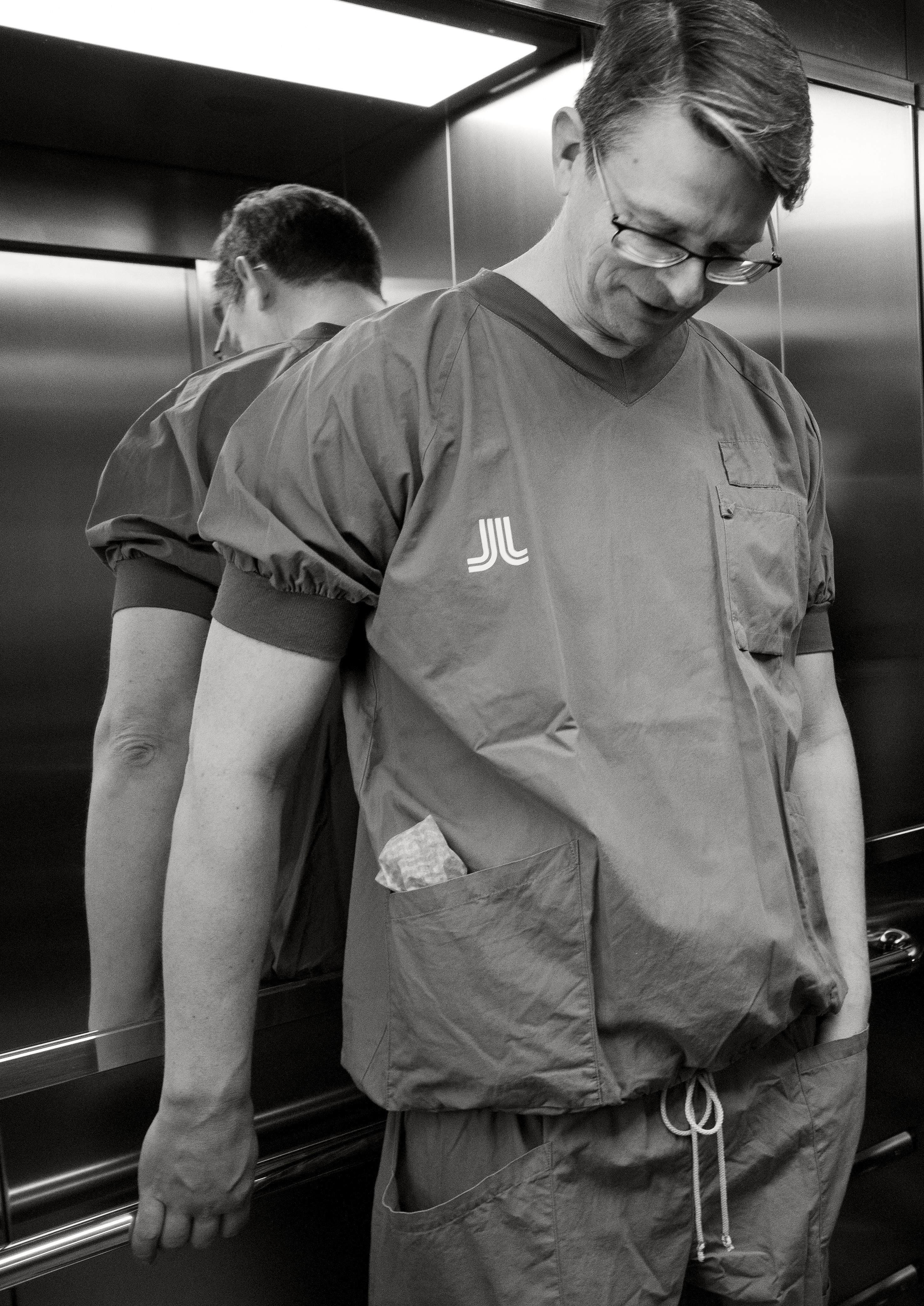 Fredrik Lanner and Anders Kvanta have been working together for over 10 years. Now they are starting a clinical trial to see whether their stem cells can help people whose vision is impaired as a result of dry macular degeneration.
Fredrik Lanner and Anders Kvanta have been working together for over 10 years. Now they are starting a clinical trial to see whether their stem cells can help people whose vision is impaired as a result of dry macular degeneration.

The study was published in Stem Cell Reports in 2016. Another important step towards a clinical trial was developing a protocol for producing retinal pigment cells from stem cells in a scalable manner, which they published in Nature Communications in 2020.
Fredrik Lanner points out that they are replacing precisely the cells that have been damaged.
“Unlike some irresponsible studies which simply inject stem cells and hope for the best, we know exactly what kind of cells we are working with and what quantities we are using,” he says.
“So there we were with our cultivated cells and couldn’t get any further.”
The new clinical trial will commence in 2025 and will involve 15 patients with severe dry macular degeneration. Both eyes should be affected, and the one worst affected will be treated. Anders Kvanta will then perform vitreoretinal surgery, which involves removing the vitreous body so that the surgeon can access the retina. The new cells are then injected under the retina using a fine needle.
“We create a small, controlled retinal detachment by forming a small blister. Nature then flattens the blister elegantly within a day, and hopefully we have then created the layer of cells that we saw in the rabbits,” he says.
To prevent rejection of the cells by the immune system, the patient will receive cortisone in tablet form. In addition, an implant the size of a grain of rice will be placed in the eye to release cortisone locally for three months.
The results will be measured using imaging techniques to study the extent of the area with dead cells, but also to study how the new cells are integrated into the eye. This can be observed using a type of layer-bylayer X-ray called optical coherence tomography, in which many two-dimensional images are combined to form a three-dimensional image.
“After all, we also want to measure how the retina above the transplanted cells is doing,” says Anders Kvanta.
This is done using a completely new technology, adaptive optics, where individual cells can be seen as small rings.
The researchers will also continuously gather information on how the patients experience the situation and whether they possibly notice any change in their vision. They have chosen not to carry out ‘placebo
surgeries’ where the surgery is performed without adding any cells; instead, all patients in the study will receive actual treatment.
“It’s not ethically justifiable to operate on people’s eyes if there is no chance of improvement,” says Anders Kvanta.
Fredrik Lanner points out that the same applies to other cell therapies, such as trials where patients with Parkinson’s disease are treated with cell transplants in the brain.
“There has been a paradigm shift and the authorities now consider that this type of trial both can and should be carried out without a true control group,” he says.
In their case, the patient’s untreated eye can also serve as a kind of internal control.
So what does the financial support from the Erling-Persson Foundation mean? On this, Fredrik Lanner is very clear:
“It’s absolutely crucial for being able to conduct the trial.”
He describes how they previously collaborated with Danish pharmaceutical company Novo Nordisk, which supported them in their work to develop protocols for manufacturing retinal pigment epithelial cells from embryonic stem cells. But just over a year ago the company made the strategic decision to stop working on ophthalmic drugs entirely.
“So there we were with our cultivated cells and couldn’t get any further,” says Fredrik Lanner.
Anders Kvanta adds:
“With the support from the Foundation we can now carry out the first clinical trial on humans, and test our method in practice. We have high hopes for getting good results, but it will take a few years,” he says.
24
FACTS
The common age-related disease macular degeneration (AMD) leads to blindness. The disease exists in two variants, wet and dry.
In this project the researchers aim to treat dry macular degeneration, which occurs due to the death of retinal pigment epithelial (RPE) cells. The symptom is central vision loss, often described as ‘blurriness in the middle’, making it difficult to read and to recognise faces. Currently, there is no approved treatment in Europe.
The disease becomes more common with age. For people of European descent the prevalence at group level is 0.7 percent at age 70, just under 3 percent at age 80 and over 11 percent at age 90.
The other variant, wet macular degeneration, results from the overgrowth of blood vessels in the macula. This can be treated with anti-vascular drugs injected into the eye.
180
180 million people globally live with dry macular degeneration. In Sweden 1,500 people are diagnosed each year and roughly 100,000 are living with impaired vision as a result of the disease.
1
1 millimetre in diameter
– that’s the size of the area on the retina known as the macula, which is necessary for us to see sharply, read and recognise faces.
ABOUT THE PROJECT
100,000
The approximate number of cultured retinal pigment epithelial cells that will be injected under the retina in the trial.
Project leads: Anders Kvanta and Fredrik Lanner.
Title: A first-in-human linked clinical trial om embryonic stem cell-derived retinal cells for macular degeneration.
What it involves: A clinical trial in which patients with dry macular degeneration are treated with retinal pigment epithelial cells produced from embryonic stem cells.
Funding: The Erling-Persson Foundation is supporting the project with SEK 10 million over three years.
25
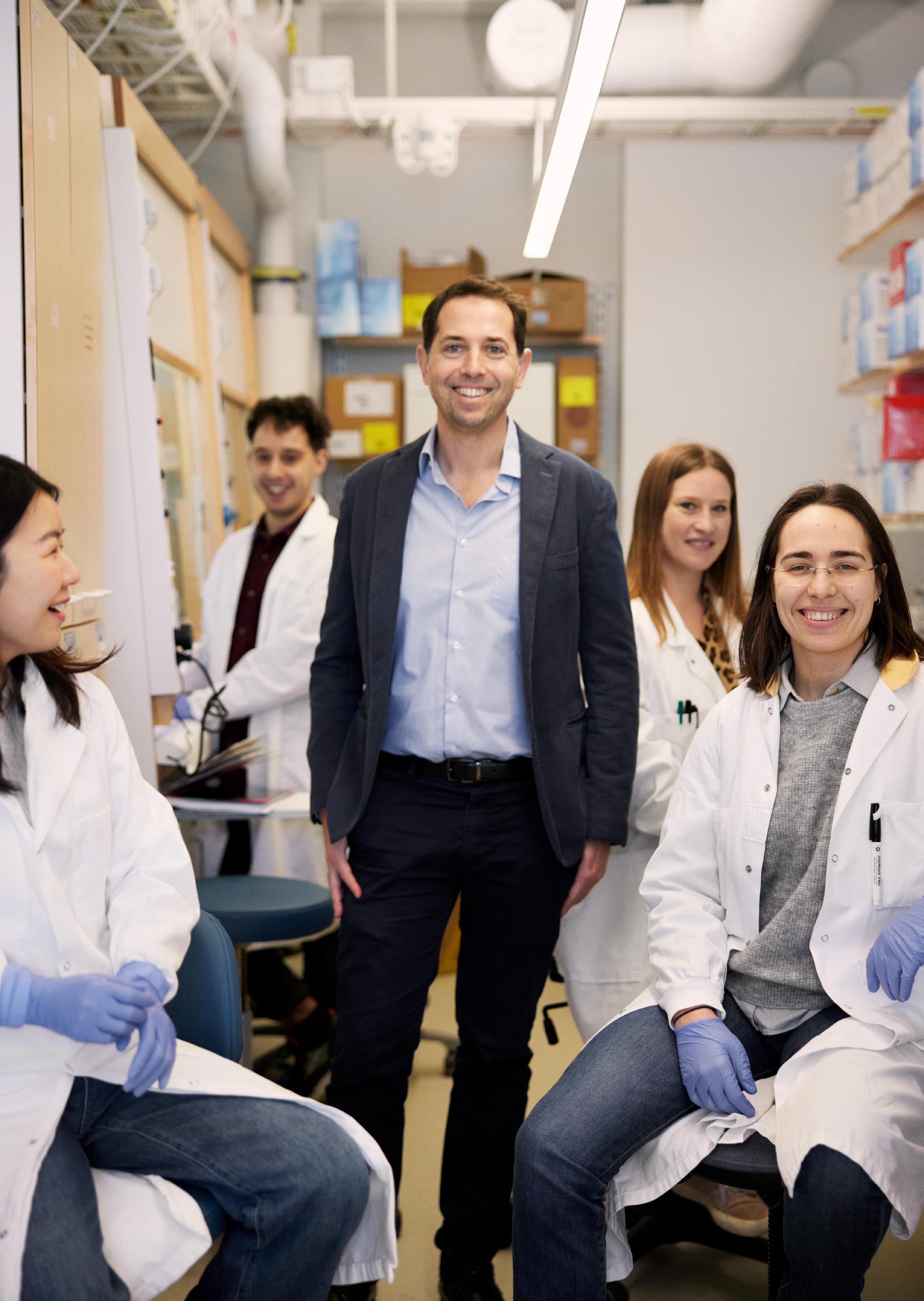 From left: Yike Xie, Paolo Valentini, Joan Camuñas-Soler, Sandra Postic and Marta Gironella.
From left: Yike Xie, Paolo Valentini, Joan Camuñas-Soler, Sandra Postic and Marta Gironella.
SEK 15 M / 5 YEARS
AIMING TO EXPLAIN HOW BETA CELLS INTERACT WITH THEIR NEIGHBOURS
To better understand insulin-producing beta cells Joan Camuñas-Soler will develop methods to investigate them and their interactions in a more systematic way. The knowledge generated may form the basis for future treatments.
Every year 1,800 Swedes are diagnosed with type 1 diabetes, half of them children. This means the body stops producing the hormone insulin; those affected must administer it via injections from day one. The lifesaving hormone insulin was discovered in 1921, and just the following year the first patient’s life was saved with the help of injected insulin. The discovery was awarded the Nobel Prize in Physiology or Medicine in 1923.
The cells normally responsible for insulin production are beta cells, which are found in the islets of Langerhans in the pancreas. These cells, and their interactions with each other, are the focus of a project called Physiological profiling of excitable cell types using spatially-resolved patch-seq microscopy, led by Joan Camuñas-Soler, assistant professor in bioinformatics for translational medicine at the University of Gothenburg. His decision to study beta cells in particular was based on many factors beyond their importance in type 1 diabetes.
“Beta cells are unique in that when you culture them, they spontaneously form small mini-organs – known as cell islands – in the culture dish.”
“Beta cells are unique in that when you culture them, they spontaneously form small mini-organs – known as cell islands – in the culture dish,” he says.
Studying such mini-organs in the laboratory is
hot in many fields, including neurology, but it can be difficult to get the cells to clump together in a biologically functional way.
“In our small cell islands the cells interact with each other, just as in the pancreas. This makes them a good model for studying how cells affect each other,” says Joan Camuñas-Soler.
Another important factor is that beta cells are excitable, meaning they can respond to electrical signals.
“That also applies to other cells in the body, with heart cells probably the most well-known,” he says.
In simplified terms the project can be described as the researchers wanting to develop robust analysis methods for studying healthy cells. They want to understand more precisely how the cells’ internal machinery normally functions, both in terms of which genes are active and what the cells’ physiological and electrical activity looks like. To better understand the role of different cells, cells that interact with each other in a tissue are examined. Based on this information it is then possible to investigate what looks different in various diseases when, for some reason, cells do not function as they should. The long-term goal is to find ways to restore these deficient functions.
The project has three distinct parts. The first involves scaling up the analysis method developed by Joan Camuñas-Soler, but which has so far been very resource-intensive. This method involves reading the cell’s transcriptome – all the RNA molecules generated by active genes – using a technique called RNA sequencing. The method also includes what is
27
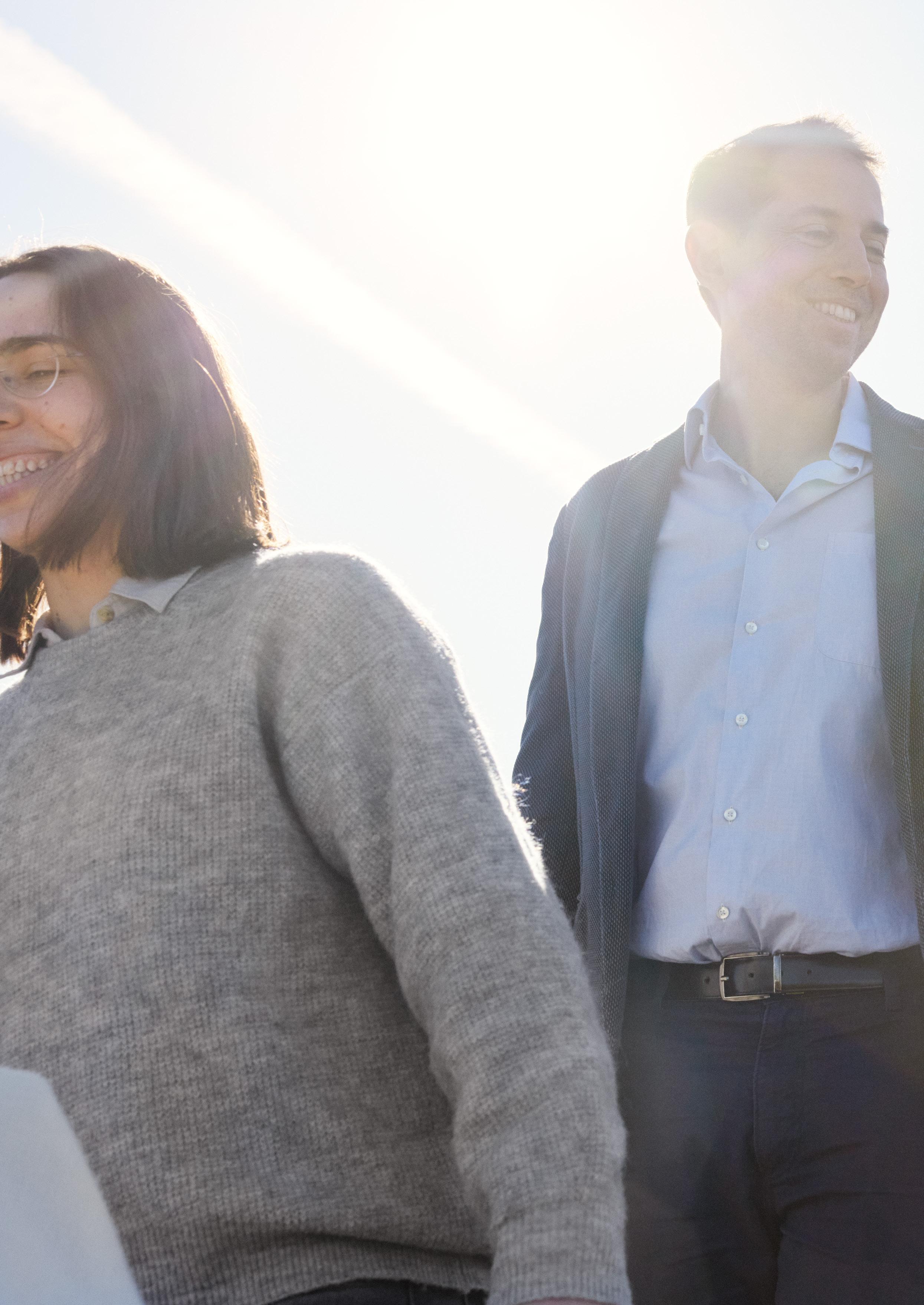 From left: Marta Gironella, Joan Camuñas-Soler, Sina Amirnezhad, Sandra Postic and Oliver Forsell.
From left: Marta Gironella, Joan Camuñas-Soler, Sina Amirnezhad, Sandra Postic and Oliver Forsell.
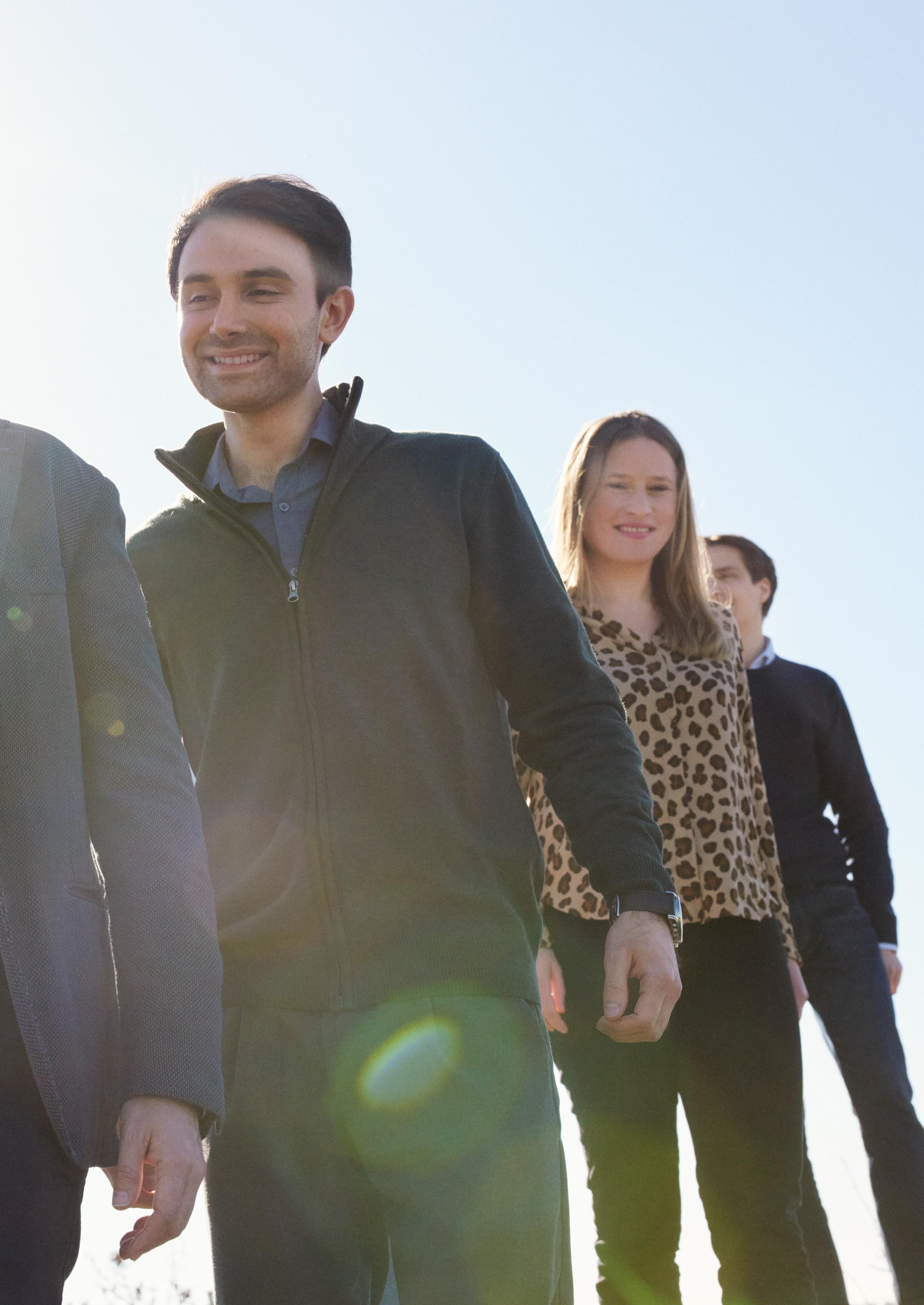
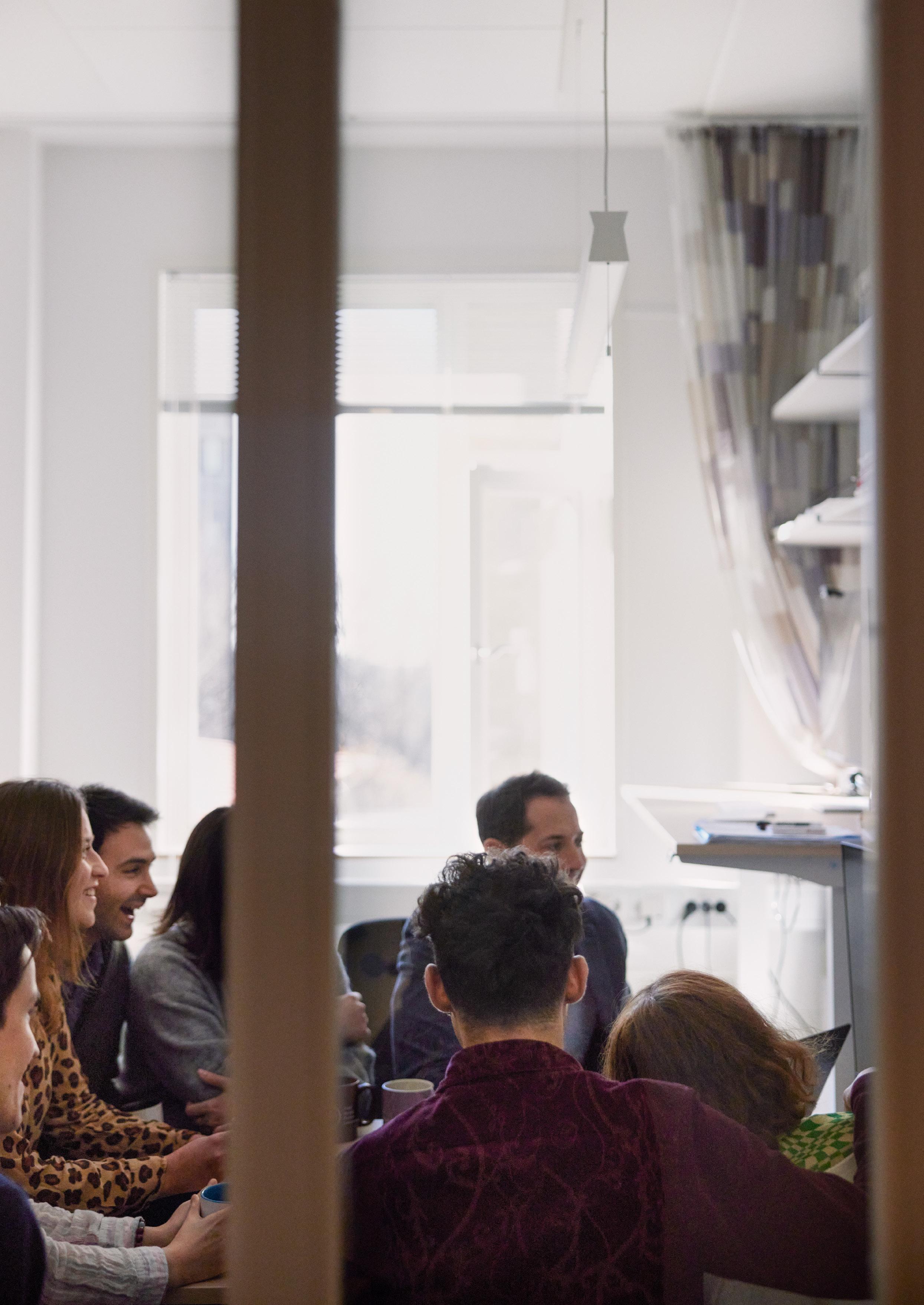

Joan Camuñas-Soler’s group will analyse pancreatic tissue. “In tissue sections we can map how the cells behave and interact in both healthy and diseased tissue, in order to understand which genes are malfunctioning in disease.”
31
known as a patch clamp, which involves measuring the cell’s electrophysiological activity. The combination of these two is called patch-sequencing (patch-seq).
“Gathering data on a thousand cells took one person over a year, because each cell needed to be captured via pipette and then sequenced and analysed electrophysiologically, so it was extremely timeconsuming,” says Joan Camuñas-Soler.
He used patch-seq to identify 484 genes that were specifically active in beta cells and this was published in Cell Metabolism in 2020. The goal now is to scale up the analysis to make it possible to collect and analyse a thousand cells in a week, rather than a year.
“The goal now is to scale up the analysis to make it possible to collect and analyse a thousand cells in a week, rather than a year.”
“Access to a larger number of cells also makes it possible to identify populations of cells that are not so common,” he says.
Previously, for example, it was believed that all insulin-producing beta cells were the same. Today it is known that there are certain subgroups of beta cells, and now the task is to find out if any of these subgroups might cause disease.
“The hope is that patch-seq will be able to provide that information,” says Joan Camuñas-Soler.
The second part of the project involves building a cell atlas to link a cell’s transcriptome with its functional identity. Here they want to use methods such as machine learning (AI) to make predictions about the electrophysiological properties of cells where researchers lack electrophysiological information.
In the third part of the project they want to analyse samples from healthy individuals and from patients with type 1 diabetes. Here Joan Camuñas-Soler emphasises the importance of networking and explains that in Uppsala, they are responsible for collecting pancreases to be transplanted into people with type 1 diabetes.
“The idea is that within a year or two, we’ll have samples where we can map in tissue sections how the cells behave and interact in both healthy and diseased tissue, in order to understand which genes are malfunctioning in disease,” he says.
The plan is also to test the methodology on other types of cells than beta cells, with heart cells (cardiomyocytes) possibly first in line.
“Since Gothenburg is highly renowned in cardiovascular disease, there’s a great opportunity for collaboration here,” says Joan Camuñas-Soler.
He is fundamentally a physicist, a somewhat unusual background for a cell biologist.
“Biology is extremely complex, but we are now at a stage of technological development where biological data can be used to formulate larger principles – as has long been done in physics. Thanks to sequencing technology and data processing we can now make very precise quantitative measurements within biology, too, which I find fascinating,” he says.
With his background in physics he previously had little time for applied research. But this has now changed, partly due to the postdoctoral post he held at Stanford University in the USA.
“There I worked with Stephen Quake, who is a fantastic researcher but is also known for his innovations and for having started lots of companies,” he says, continuing:
“It gave me a different perspective. Basic research is important because it enables us to understand how things work, but in fields like genomics, basic research can also be transformed into productive applied ideas. Which is excellent, because people need to understand that the research conducted at universities can also be used for something – such as curing disease.”
“Thanks to sequencing technology and data processing we can now make very precise quantitative measurements.”
The support from the Erling-Persson Foundation means a lot.
“The grant was fantastic and, quite simply, is what is enabling us to carry out this ambitious project – so I am extremely grateful,” he says.
Finally, what does the project’s ‘nickname’ Physioscope mean?
“In the same way that a whole new world opened up when humans invented the microscope and were able to look into cells, today we can use sequencing techniques to look at a cell’s genes with a resolution that details individual bases in the genome. The hope is that we will now expand that knowledge and also understand how cells behave and interact,” says Joan Camuñas-Soler.
32
25,000
The number of electrodes on the chips used to measure cell activity.
1
Healthy individuals have around one million beta cells, corresponding to about 1,000 per Langerhans islet in the pancreas.
ABOUT THE PROJECT
Project lead: Joan Camuñas-Soler.
Title: PHYSIOSCOPE
484
The number of genes that are specifically active in beta cells.
– Physiological profiling of excitable cell types using spatially-resolved patch-seq microscopy.
What it involves: The aim is to develop methodology that will enable researchers to link a cell’s transcriptome – all the RNA transcripts that the cell produces in a certain time – to its function and its physical location in a tissue. Beta cells from the Langerhans islets in the pancreas, which are important in the development of type 1 diabetes, are used as a model. The idea is also to investigate other types of cells, such as cardiomyocytes from the heart.
Funding: The Erling-Persson Foundation is supporting the project with SEK 15 million over five years.
33
AIMING TO IRRADIATE A FAST-GROWING AND DEADLY CANCER
Today there are good treatments available for many types of cancer, but some variants still have a very poor prognosis. Now Marika Nestor and her colleagues are aiming to attack a particularly aggressive type of cancer with a unique zform of targeted radiotherapy.
Advancements in cancer treatments have yielded significant successes over the past thirty years. For many diagnoses, what was once a death sentence has been transformed into a chronic – and sometimes curable – disease. But unfortunately this does not apply to all types of cancer. One particularly malignant form is called anaplastic thyroid cancer, which has a very poor prognosis and is characterised by undifferentiated cells. Marika Nestor, a professor in biomedical radiation sciences at Uppsala University, has identified a molecule present on the surface of certain cancer cells. By attaching radioactive lutetium to an antibody that recognises this target, it is possible to direct radiotherapy specifically at these cancer cells. The target molecule CD44v6, for example, is present on cancer cells in anaplastic thyroid cancer.
“Working with targeted radiotherapy is a great advantage – you can monitor how it progresses over time.”
“When I asked around at the local hospital about who was responsible for these patients, I was told ‘there’s no-one specifically in charge of them – they usually pass away before we get that far’, which of course was a terrible thing to hear,” she says.
In the project Clinical translation of antibody-based molecular radiotherapy of advanced thyroid carcinoma the goal is to conduct an initial clinical study. In this she is collaborating with
clinicians at Karolinska University Hospital in Solna. Jan Zedenius, a professor of endocrine surgery, is blunt about the situation:
“It’s the worst human cancer. What we can do is surgically remove as much tumour as possible so that the patient gets to die a regular cancer death from their metastases. In cases where surgery isn’t possible, the tumour strangles the patient within three months... I’ve seen tumours grow visibly on the neck between the morning and evening rounds, so we are in desperate need of new treatment,” he says.
Renske Altena, a medical oncologist specialising in breast cancer and researcher at Karolinska Institutet, adds:
“Other types of cancer have a patient association that survivors engage with, but not in this case,” she says.
The team also includes Rimma Axelsson, a professor of nuclear medicine.
“When we want to start studies involving new radiotherapy it’s important to be able to assess the doses absorbed, how the radiation source is distributed in the body and so on,” she says.
Along the way to the clinical trial Marika Nestor has been able to demonstrate good effects in animal experiments. In studies with mice, which had had human tumour cells implanted under the skin, it was observed that the targeted antibody coupled with the radioisotope lutetium 177 not only found the tumour cells, but also killed specifically those cancer cells. In a comparative study it was observed that in mice receiving the active antibody the tumours melted away,
SEK 6 M / 3 YEARS
34

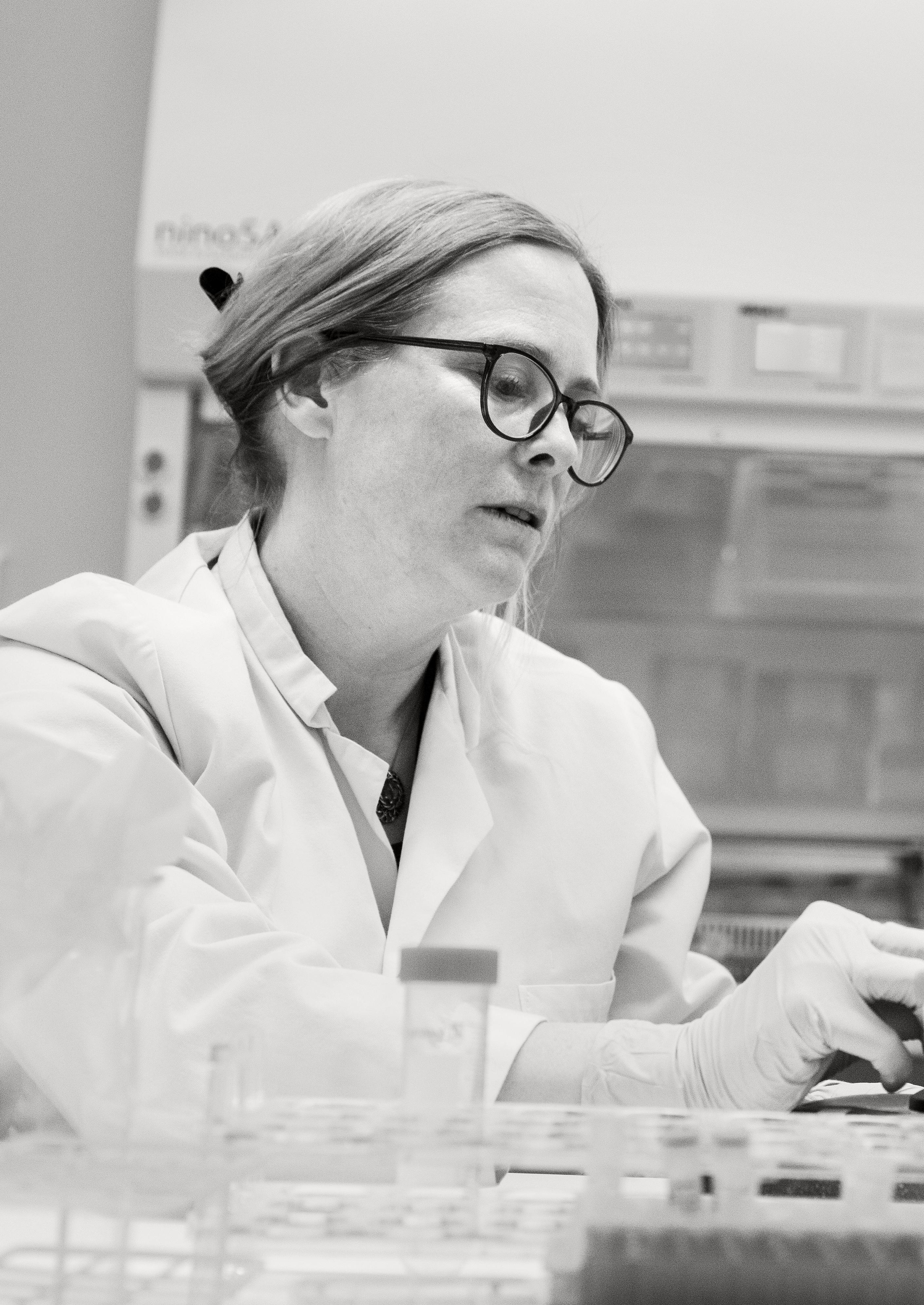
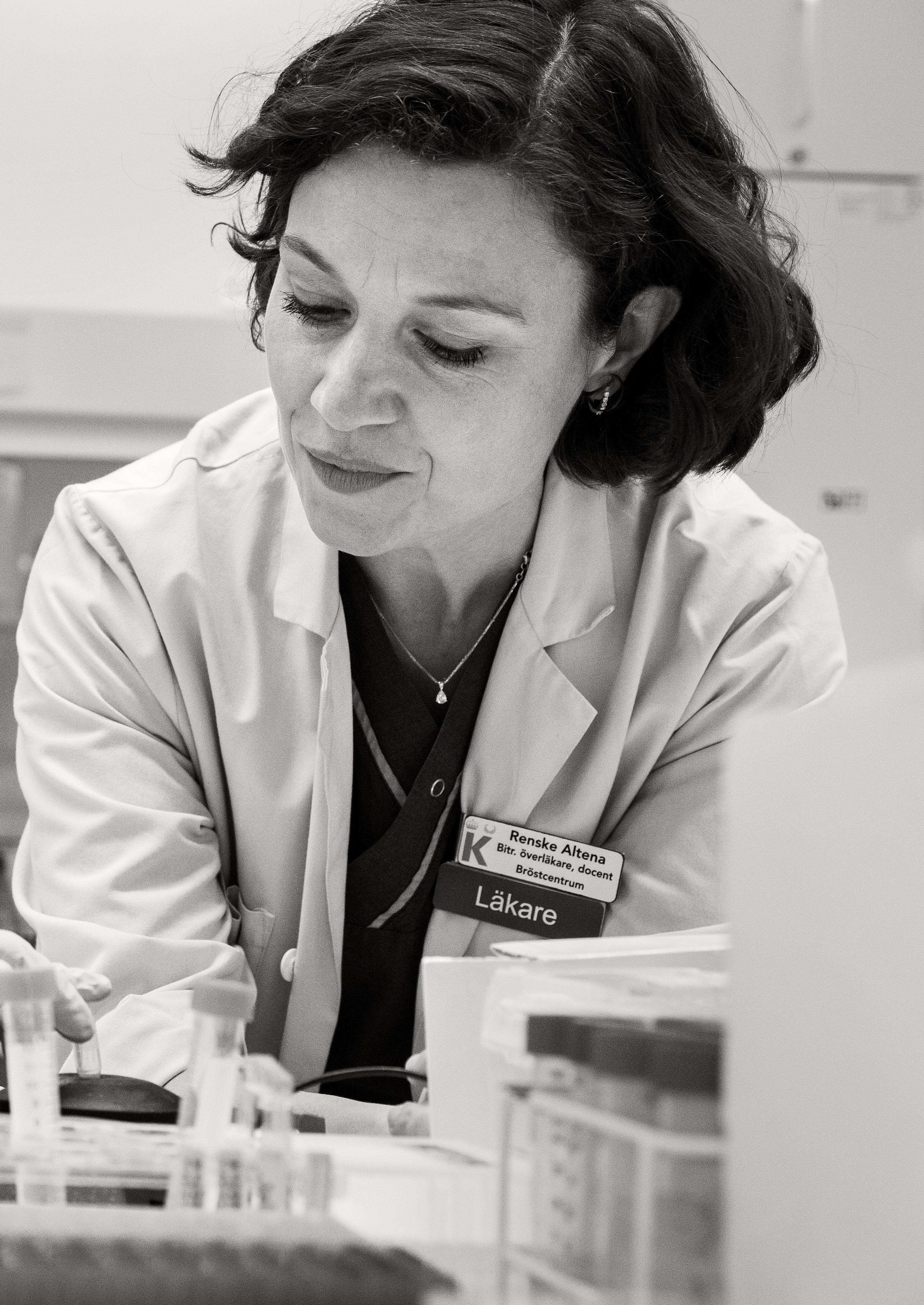
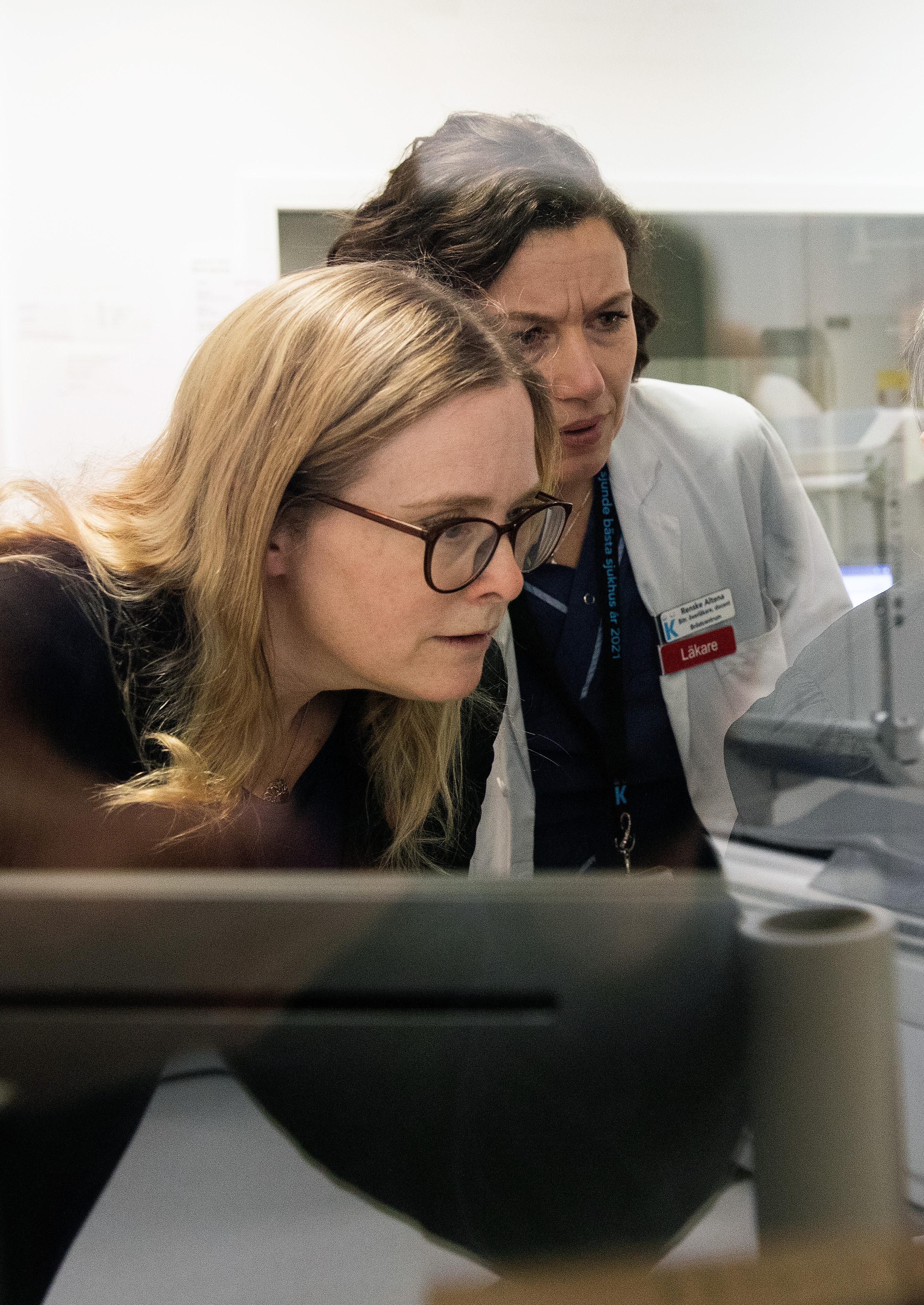 Marika Nestor (left) highlights the role of her clinical colleagues Renske Altena, Rimma Axelsson and Jan Zedenius. “My role is reducing as we hand over more to those who have contact with the patients and can perform the imaging studies.”
Marika Nestor (left) highlights the role of her clinical colleagues Renske Altena, Rimma Axelsson and Jan Zedenius. “My role is reducing as we hand over more to those who have contact with the patients and can perform the imaging studies.”

while control mice receiving the inactive antibody died. Since then she has withheld her results and not published any articles.
“Not being able to publish is something of a paradox for a researcher. But we knew for sure that we wanted our antibody to be able to be used for treatment, and for that it needed to be patented. Now we have various articles on the way to being published,” says Marika Nestor.
In the upcoming clinical trial the research team will treat patients in two rounds. First, a group of three to six individuals will receive a very low dose. The dose must be low enough that the risk of side effects is negligible, but it must allow imaging technology to track how long the antibody remains in the blood and how well it reaches the patient’s tumour and its metastases.
“Working with targeted radiotherapy is a great advantage – you can monitor how it progresses over time. It’s also gentler than external radiation, especially if the patient has many metastases,” says Rimma Axelsson.
“Safety is paramount, and patients will be closely monitored after the first dose.”
Safety is paramount, and patients will be closely monitored after the first dose to ensure that the side effects are not serious while slightly higher doses are tested.
In other contexts an increased risk of secondary blood cancer has been observed after radiation.
“But for our patients, it’s conceivable that a one percent or so risk of developing leukaemia after thirty years might be worth taking,” says Marika Nestor.
While it is essential that patients with anaplastic thyroid cancer are able to participate in the trial, there are also openings for other types of cancer provided the cancer cells have the same target molecule on the surface. This applies, for example, to certain forms of lung cancer, variants of head and neck cancer, and some gynaecological cancers such as vulvar cancer.
“The latter group is characterised by a lack of effective treatment options, so these patients have more or less ongoing clinical trials,” says Renske Altena.
All four emphasise the importance of working as a team, with everyone’s different expertise contributing to the whole. Marika Nestor highlights the role of her clinical colleagues.
“My role is reducing as we hand over more to those who have contact with the patients and can
perform the imaging studies,” she says.
The support from the Erling-Persson Foundation is very welcome.
“It makes all the difference! We’ll be able to conduct a good, independent academic study that we design based on our expertise,” she says. Renske Altena continues:
“It gives us an opportunity to evaluate something that could help our patients without having to be limited by commercial interests.”
Rimma Axelsson emphasises that a peer-reviewed grant gives the study a stamp of quality.
“It shows that there are others who believe we are on the right track,” she says.
The research team hopes that in three years’ time they will be ready to plan a larger clinical trial involving more patients. Time will tell whether that is so. But even if the work does not lead to a drug, the trial is still important, believes Jan Zedenius.
“Perhaps targeted radiotherapy can serve as a neoadjuvant, meaning that tumours can be shrunk so that previously untreatable tumours become surgically accessible,” he says.
And Marika Nestor poses a rhetorical question:
“With the fantastic preclinical data that we have – if we’re not going to proceed to a clinical trial now, when will we?”
40
FACTS / THYROID CANCER
There are several variants of cancer in the thyroid gland, with widely differing prognoses. The variants papillary and follicular thyroid cancer have a very good prognosis. Cancers that are not sensitive to iodine are called iodine-resistant, and here the 10-year survival rate is less than 10 percent. Anaplastic thyroid tumour is the most serious variant.
Anaplastic thyroid cancer affects 25–40 people in Sweden each year. At diagnosis around half of patients already have metastases, often in the lungs. Surgery is the only way to treat the tumour. The aim is to remove as much tumour mass as possible; otherwise, the cancer strangles the patient. Average survival after diagnosis is four months.
FACTS / TARGETED RADIOTHERAPY
Today there are two approved drugs that use targeted radiotherapy: Pluvicto for metastatic prostate cancer and Lutathera for neuroendocrine tumours.
Both of these use lutetium 177 as radiation source. But unlike Marika Nestor’s variant where the isotope is linked to a targeted antibody, these two targeted therapies are based on peptides.
2
2 million target molecules can be present on the surface of a cancer cell. This is many orders of magnitude more than on healthy cells. Researchers have seen good effects in animal experiments even with sparser distribution of around 200,000 target molecules.
25–40
The number of people affected by the dreaded anaplastic thyroid cancer each year in Sweden.
50%
Half of patients with anaplastic thyroid cancer have a variant with the target molecule CD44v6 on the surface. In the trial all patients are tested, so that only those who have a chance of benefiting from the treatment are included.
ABOUT THE PROJECT
Project leads: Marika Nestor with Renske Altena, Rimma Axelsson and Jan Zedenius.
Title: Clinical translation of antibody-based molecular radiotherapy of advanced thyroid cancer.
What it involves: A targeted antibody has been attached to the radioisotope lutetium, and with this researchers will treat patients with conditions such as anaplastic thyroid cancer, for which there is currently no effective treatment.
Funding: The Erling-Persson Foundation is supporting the project with SEK 6 million over three years.
41
IMPROVING THE CHANCES FOR PATIENTS WITH EYE MELANOMA
Jonas Nilsson, University of Gothenburg
SEK 10 M / 3 YEARS
Eye melanoma (also known as ocular melanoma) is a rare disease, affecting about 80 patients per year in Sweden, but has a greatly reduced survival rate due mainly to metastases to the liver.
In previous studies the research group has investigated the effect of chemotherapy treatment locally in the liver for metastases, and also stimulation of so-called immune checkpoint inhibitors (ICI).
Both strategies have been shown to inhibit tumour growth. Now the group plans to carry out various combinations of treatments involving ICI, chemotherapy and modification of a certain type of immune system cells (T cells) that can attack tumour cells. The hope is that the research programme will now lead to a significant breakthrough in the treatment of the disease.
TEXTILE MUSCLES REINFORCE GARMENTS
Edwin Jager, Linköping University
SEK 6 M / 3 YEARS
An orthosis provides functional external support for a body part. It can be used, for example, to relieve pain, counteract malpositioning and achieve improved mobility in a patient. Development is now rapidly moving towards orthoses that not only support but also add artificial muscle power that actively helps the wearer to restore or even increase their mobility – and thus their ability to deal with various everyday challenges.
As part of a unique and world-leading interdisciplinary collaborative project between Linköping University and the University of Borås, active textile orthoses are now being developed. In the project researchers combine advanced textile processing, including knitting and weaving, with new electroactive polymers, including ‘smart’ materials that deform in response to electrical stimulation. The materials
developed can also be used in ‘exo-garments’ to facilitate the work of, for example, healthcare providers who carry out heavy lifting on a daily basis or craftsmen who regularly use heavy tools. Both occupational groups frequently suffer from severe and often chronic repetitive strain injuries, often at a young age.
RAPID DIAGNOSIS OF SEPSIS
Agneta Richter-Dahlfors, Karolinska Institutet
SEK 6 M / 3 YEARS
Sepsis is a life-threatening condition that involves bacteria entering the bloodstream, causing disturbances in several internal organs and, in its most severe form, the inability to maintain normal blood pressure.
A major dilemma in diagnosis is that patients in the early stages have relatively vague symptoms, which can make it difficult to decide whether the patient should be treated aggressively or not. Blood cultures are taken, but it can take a long time to receive results from these, especially if there are few bacteria in the bloodstream.
Agneta Richter-Dahlfors and her colleagues have developed a diagnostic method that involves rapid separation and enrichment of bacteria in the blood along with ‘optotracing’ (fingerprints for specific species of bacteria) in combination with modern data processing. This enables results to be obtained within an hour confirming whether there are bacteria in the blood.
Eventually this will enable medical staff to focus on the patients who really need intensive care and to avoid antibiotic treatment where the probability of sepsis is low.
DIAGNOSING, PREVENTING AND TREATING METASTATIC CANCER THROUGH A UNIQUE SIGNALLING PATHWAY
Maréne Landström, Umeå University SEK 6 M / 3 YEARS
Prostate cancer is the most common form of cancer among men. Maréne Landström and her
OTHER DONATIONS 42
colleagues have found a key, at molecular level, to the fact that the cancer sometimes spreads and becomes highly resistant to treatment.
This consists of abnormal signals in a growth factor system, TGFß. In normal circumstances TGFß signals cause the cell to stop dividing; in cancer cells, in contrast, the signal incorrectly activates genes that cause the cell to begin uncontrollable growth – resulting in metastatic cancer.
The research group has developed an antibody that can prevent the development of metastases from prostate cancer by affecting this system. The antibody has proved to be effective in a model for prostate cancer and the group will now proceed to investigate how the signalling pathway behaves in human cancer. There is also data suggesting that other types of cancer which also form metastases could be treated with the antibody.
CANCER TREATMENT TARGETING LOSS OF GENETIC INFORMATION
Tobias Sjöblom, Uppsala University SEK 6 M / 3 YEARS
Cancer is defined as uncontrolled cell growth in the body which spreads to other organs via the blood and lymph systems. Untreated, cancer leads to death because the body’s normal cells, which have regulated growth, are outcompeted – eventually leading to failure of the body’s life-sustaining functions. The reasons for all of this are mutations in the cancer cells that result in reduced or absent sensitivity to normal control mechanisms.
Some of the genetic changes that occur in cancer cells involve the loss of large portions of a chromosome where tumour-suppressing genes are located. In connection with this the cancer cell may lose other genes that could mean increased sensitivity to chemotherapy.
Tobias Sjöblom’s team has identified two such genes, NAT2 and CYP2D6, which the team is studying to develop new cancer treatments. The group is also searching for more genes that could make cancer cells more sensitive to drug treatments.
A NEW EFFECTIVE AND GENTLE TREATMENT FOR CANCER OF THE COLON AND PANCREAS
Thomas Helleday, Karolinska Institutet
SEK 6 M / 3 YEARS
Traditional treatment of colorectal cancer and pancreatic cancer using chemotherapy disrupts cell production of thymidine, which is a building block in DNA. Chemotherapy effectively kills cancer cells but also affects healthy cells, with significant side effects for the patient.
Cancer cells have been shown to have a disrupted metabolism and Helleday’s team has observed that, unlike healthy cells, they need the enzyme MTHFD2 to produce thymidine. In the supported project the team is studying a substance that, by binding to and inhibiting MTHFD2 function, shuts down thymidine production in cells with disrupted metabolism. The hope is that the substance could be used to stop cancer cells from growing and thus keep them in check while normal cells remain unaffected.
IUFRO WORLD CONGRESS 2024 SLU
– Swedish University of Agricultural Sciences
SEK 2 M / 1 YEAR
SLU – the Swedish University of Agricultural Sciences – and its partners are organising the congress Forests and Society Towards 2050. The International Union of Forest Research Organizations (IUFRO) meets every five years and in 2024 the congress is being held in Stockholm. World-leading researchers and business leaders will gather to work towards a sustainable future in forestry, climate and society, in line with the UN’s 2030 Agenda for Sustainable Development. At the congress the latest in science and research will be presented. The exchange during the congress is expected to be highly significant in shaping the global research agenda for the future.
OTHER DONATIONS 43
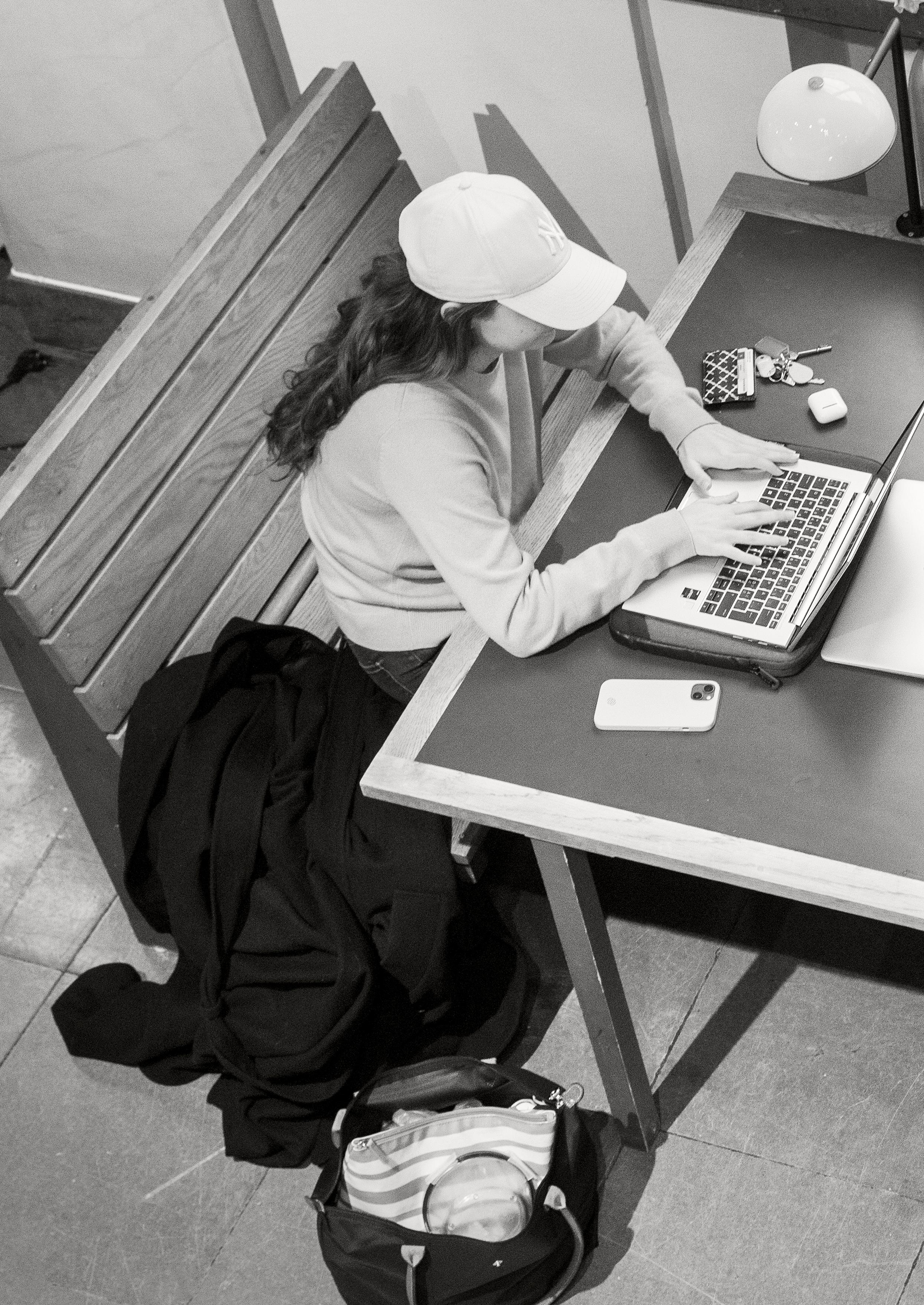
Tuition &

Education
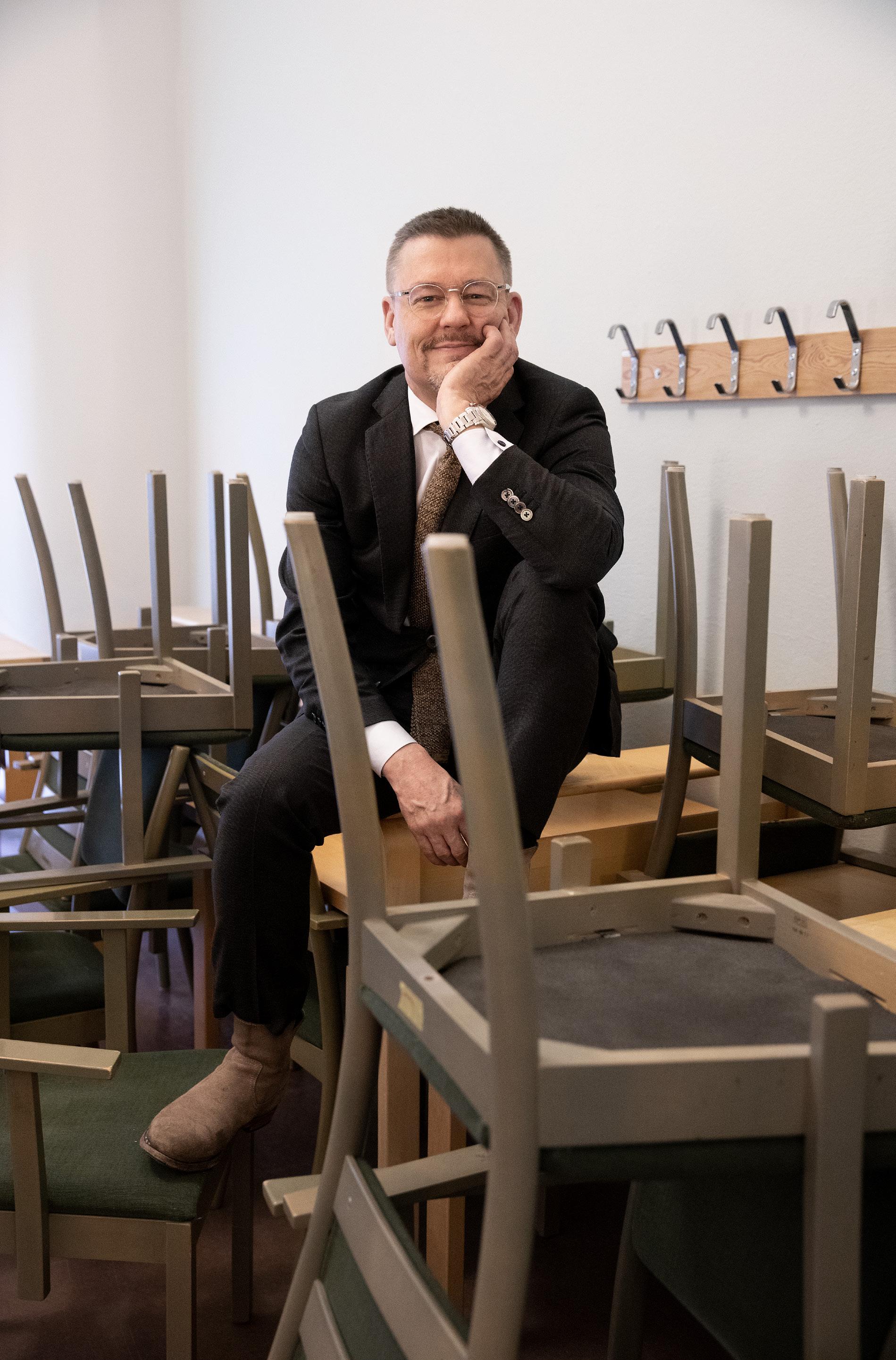
Magnus Mähring heads House of Innovation, which aims to strengthen Sweden’s competitiveness.
“Another way to describe it is that we are an innovation environment that encompasses research, education, knowledge sharing, knowledge exchange and entrepreneurship.”
46
SEK 467 M / 10 YEARS
AIMING TO ENHANCE SWEDEN’S COMPETITIVENESS
Five years on, the House of Innovation at the Stockholm School of Economics is receiving renewed and extended support to conduct research and education for another 10 years. Magnus Mähring highlights the fact that this well-developed environment covers the entire spectrum from research to entrepreneurship.
How would Magnus Mähring, holder of the ErlingPersson Chair in Entrepreneurship and Digital Innovation at the Stockholm School of Economics, sum up what House of Innovation is?
“In very concise and general terms, House of Innovation is a tool for enhancing Sweden’s competitiveness. Another way to describe it is that we are an innovation environment that encompasses research, education, knowledge dissemination, knowledge exchange and entrepreneurship,” he says.
Mähring says that the 10 years of support will impact students at the school in many different ways.
“Firstly, there is our teaching in all the programmes, and secondly, the grant allows us to continue recruiting researchers from all over the world who meet with our students in the course of their studies,” says Magnus Mähring.
He mentions the SSE Tech Initiative (SSE stands for Stockholm School of Economics), where the intention is for more students to become good at innovation using digital technologies.
“The students’ interest in, knowledge of and awareness of the role of technology in business development will increase thanks to this funding,” he says.
The initiative has three parts: Who’s Tech, FREE Tech and Be Tech. Who’s Tech involves meeting with individuals who have had careers in the technology sector. FREE Tech consists of seminars and panel discussions about the role of technology in society.
“The idea here is that it’s important we relate to and understand technology in a way that allows us to create a good society. We are free to choose – it’s not
that technology controls us. Be Tech is about knowing enough to be part of technological development. We have coding workshops that provide concrete practical skills, for example,” says Magnus Mähring.
He also mentions the successful SSE Business Lab incubator.
“That’s also something that the students notice. Both as students and as alumni, they have access to Business Lab and can apply for help with starting a company,” he says.
He also highlights long-term but more abstract effects that the students encounter over time.
“We continue to strengthen the research environment, enabling us to sustain our programme of visiting professors and to expand and deepen collaboration with other leading research environments in our fields.
“The initiative has three parts: Who’s Tech, FREE Tech and Be Tech.”
Over time this benefits the students, as we have more to tell them and to contribute,” he says.
House of Innovation also influences society, believes Magnus Mähring.
“We can attract leading researchers who then become available to the community. This takes place through a knowledge sharing programme: we hold conferences, seminars, webinars and breakfast meetings in various formats where we meet practitioners, interact and exchange ideas. There is important
47
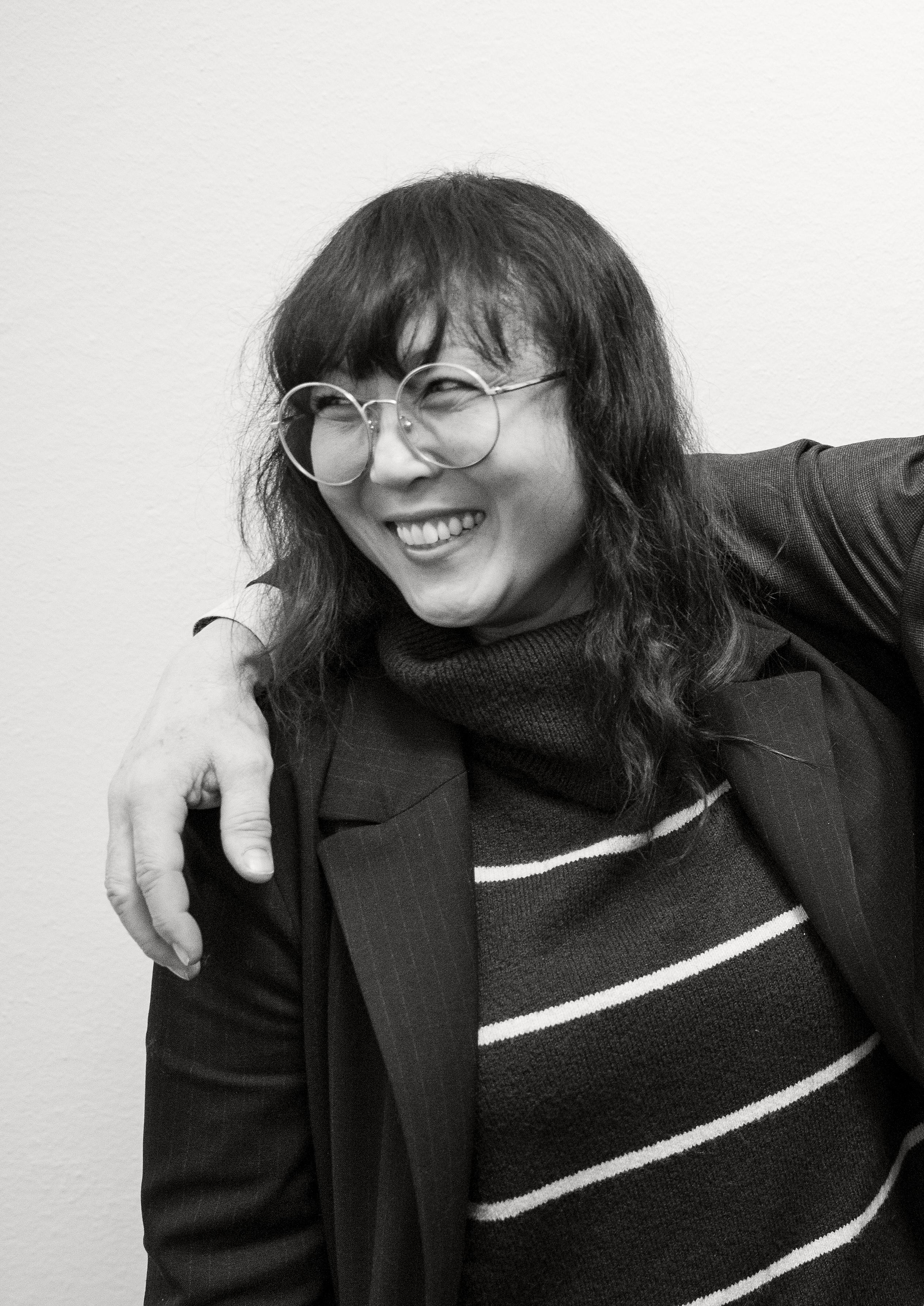 Magnus Mähring with Lee Malm, executive assistant at House of Innovation.
Magnus Mähring with Lee Malm, executive assistant at House of Innovation.
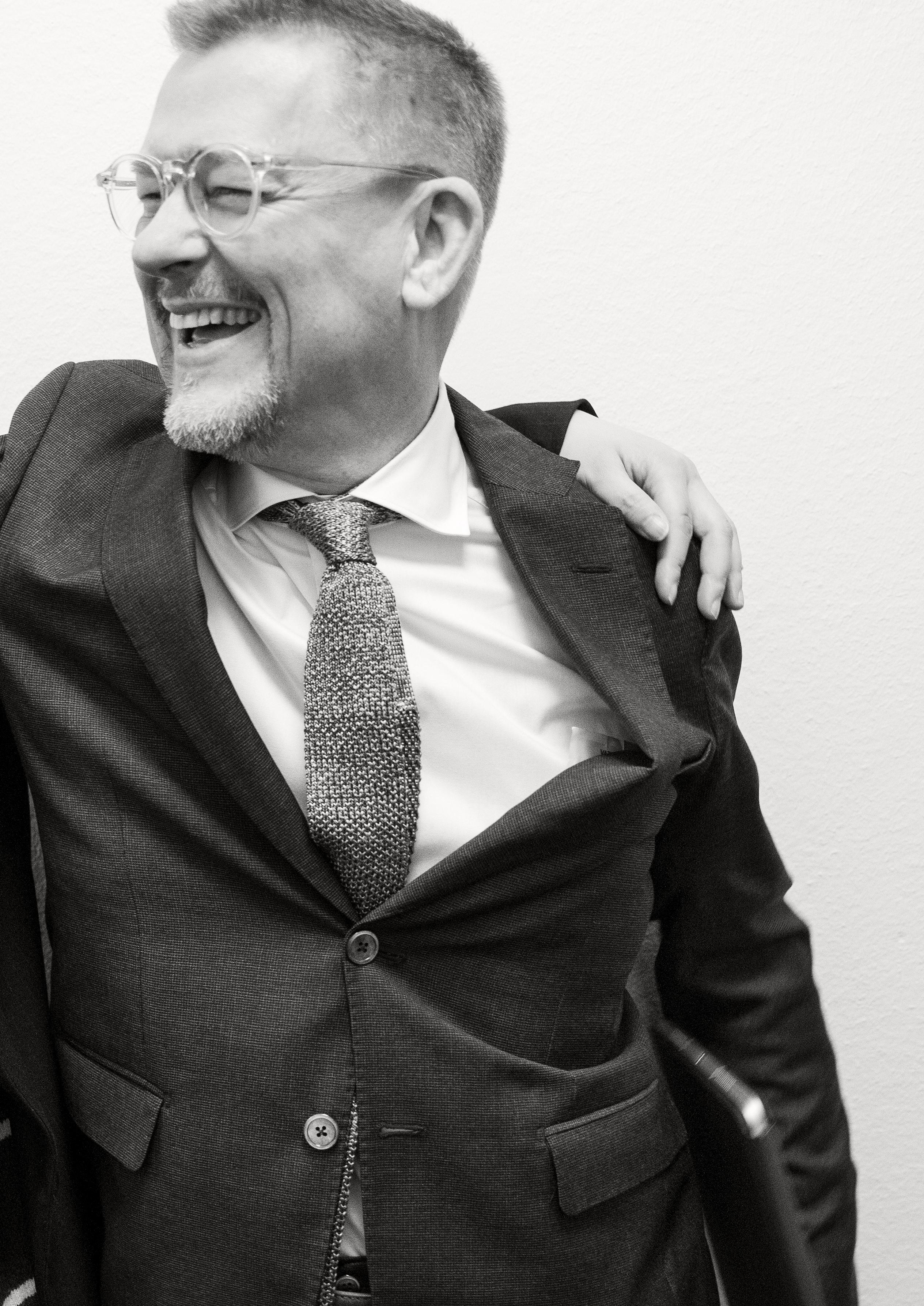
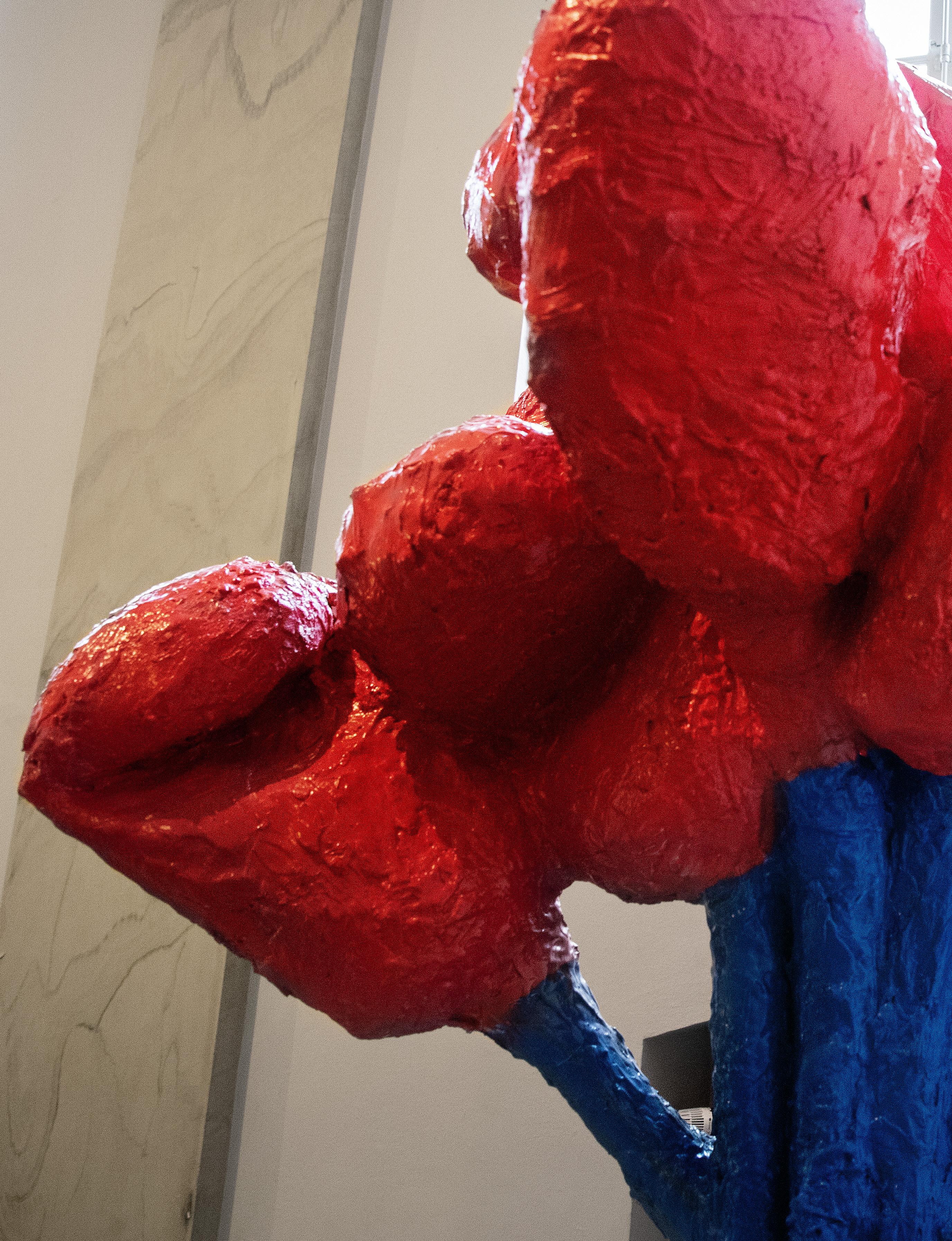
Magnus Mähring highlights the importance of FREE, an art and literature initiative. “Both art and literature broaden people’s perspectives and insights, which is why they are so central to our educational philosophy at Stockholm School of Economics.”
50

51
knowledge exchange happening there,” he says.
He points out that the educational programme itself is an important part of the knowledge sharing, but so are all the activities that bring together nearly 2,000 participants each year – such as the national initiative Digital Today, which House of Innovation has been involved in since its inception.
“We hold a flagship event called Dialogues on Digital, where hundreds of participants from politics, business, public administration and the non-profit sector discuss issues related to the digitalisation of society,” he says.
Last autumn the theme was “From Algorithms to Actions. Reimagining Work in the Age of AI”. A previous theme was “Hybrid Futures”, which focused on not assuming that everything will become digital, but rather that things will be a blend of the physical and the digital.
“What form will this fusion of physical and digital worlds take? What will reality look like when we are in both worlds at the same time?
“When AI is mixed into these very knowledge-based processes interesting and unexpected things happen.”
The house of the future must have room for direct interaction with business life,” says Magnus Mähring.
“We plan for various management groups or teams to be able to borrow a room and hold workshops or board meetings with us. Then we can offer input from our research that is relevant to what they want to work on. This guest room currently goes by the working name ‘Boardroom of the Future’,” he says.
The Stockholm School of Economics also has a clear commitment to literature and art, under the banner FREE. This acronym stands for Fact- and science-based, Reflective and self-aware, Empathetic and culturally sensitive, and Entrepreneurial and responsible.
How does this initiative connect to the state of the world?
“The logic behind our educational philosophy is that when you study at the Stockholm School of Economics, you should not only learn to excel at a number of things, but you should also grow as a person. It’s a great responsibility for us; many individuals who attend Stockholm School of Economics gain influence in society, so it’s important that they have a value system that they have had opportunity to develop during their education,” he says.
FREE lays the foundation, as this literature and arts initiative is a way to drive development of that value system.
“By reading fiction you share a fictional person’s experiences and perspectives, and they become part of your own. This allows you to practise your ability to see reality from completely different perspectives and to empathise with people from different backgrounds,” says Magnus Mähring.
The art component is also about questioning how reality is really structured, he says.
“Looking beyond what is immediately visible, understanding that everything has symbolic meaning and that there are hidden structures behind what is apparent. Both art and literature broaden people’s perspectives and insights, which is why they are so central to our educational philosophy at Stockholm School of Economics,” he says.
The FREE philosophy also runs through House of Innovation. Magnus Mähring explains that the new grant includes an initiative for research into AI and creativity.
“A crucial new element is that AI is not automating standard procedures like IT tends to do, but rather does unexpected, strange and smart things – things that also have a bearing on highly educated professions such as the medical profession, the legal profession or the daily work of researchers. When AI is mixed into these very knowledge-based processes interesting and unexpected things happen, which we now have the opportunity to focus extra on,” he says.
As for his hope for what House of Innovation will achieve, the answer is competitiveness.
“Sweden is not only one of the most innovative countries in the EU – it’s also extremely innovative in global terms, and is relatively advanced as regards sustainability. We strongly believe that research and innovation are important for creating a better and more sustainable society.”
Magnus Mähring argues that the ability to apply new technologies is key, as it is not just about having access to new technology but also creating value with complex information technologies.
“It’s about the ability; not the fact that we use them, but how. We believe that by educating supercapable individuals who will have an impact on all sectors of society, and through close links to the innovation ecosystem in Sweden and in Stockholm, we can have a big impact. It’s our job to conduct good research, share it and in that way make Sweden more sustainable – not only environmentally, but also economically,” says Magnus Mähring.
52
Finally, what does the support from the Erling-Persson Foundation mean?
“It’s absolutely crucial – without support from the Erling-Persson Foundation almost none of what we do today would exist. That’s what’s so fantastic about this grant. It provides the muscle to do things, but also infrastructure,” says Magnus Mähring, continuing: “It also strengthens other sub-activities that are
funded separately. When we have opportunity to obtain new funding, this well-developed environment – which covers the entire spectrum from research to entrepreneurship – is immediately available. Instead of launching a new initiative entirely on its own, it is placed into the existing mix that we have. So it provides completely different conditions for new ideas and initiatives to grow,” he says.
1,721
The number of people who attended House of Innovation’s events in 2023. During the year 47 events were organised, including 18 for researchers, 14 for practitioners and society, and 15 within technology for students.
9
The number of women currently employed as assistant professors at House of Innovation.
300%
The increase in research compared to five years ago. The number of researchers employed has doubled, and they have in turn doubled their productivity.
ABOUT THE PROJECT
Lead: Magnus Mähring.
Title: House of Innovation.
What it involves: A unit for research and education within Stockholm School of Economics. An innovation environment that encompasses research, tuition, knowledge sharing, knowledge exchange and entrepreneurship, which in 2023 offered over 60 courses and published more than 40 international research articles. The support builds on a previous five-year grant.
Funding: The Erling-Persson Foundation is supporting the project with SEK 467 million over 10 years.
53
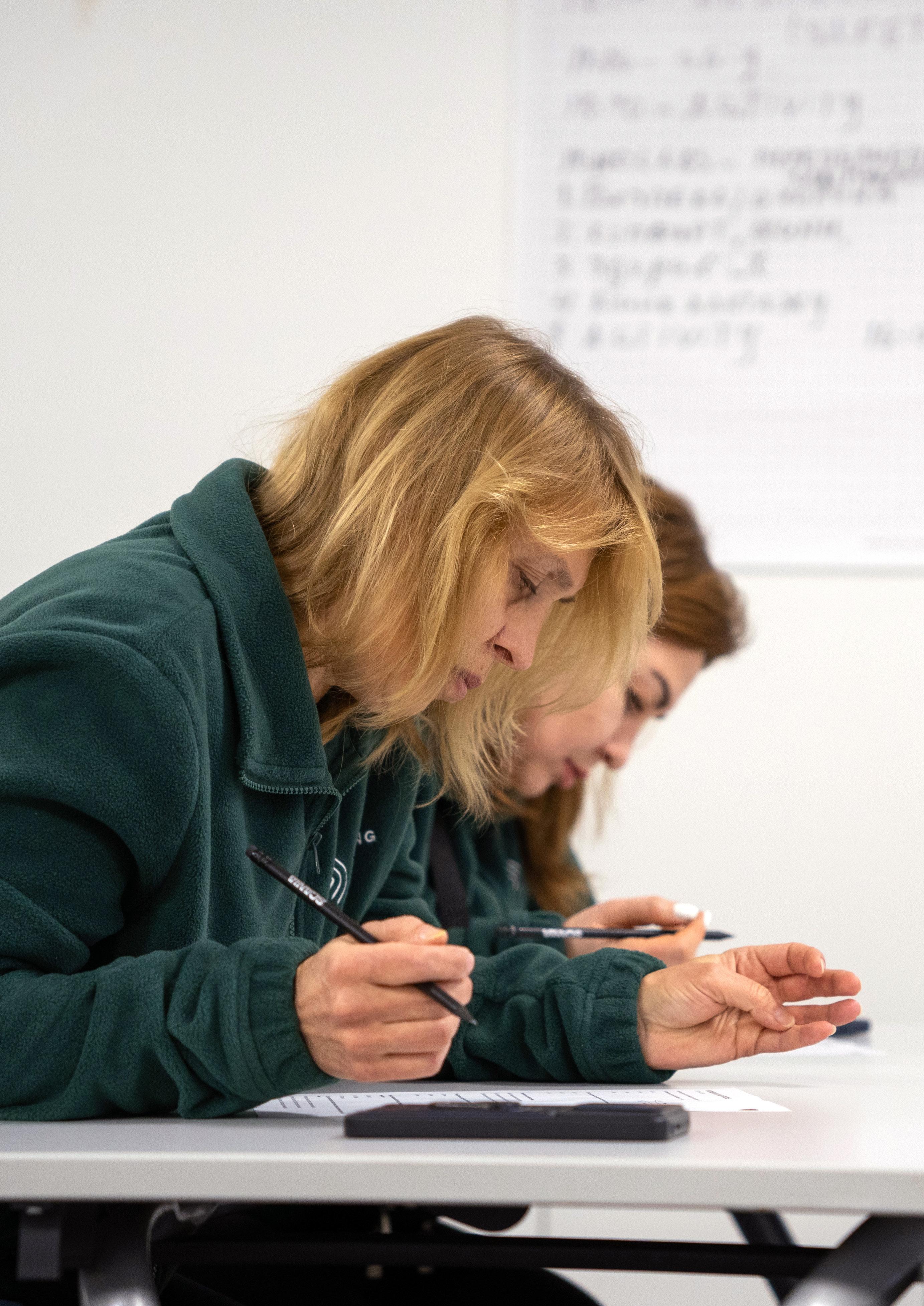
SEK 2 M / 1 YEAR
WOMEN BEHIND THE WHEEL HELP IN UKRAINE’S RECONSTRUCTION
Driver training in Ukraine aimed at Ukrainian women is a way to help more women enter the workforce and simultaneously address an acute staffing shortage. The project also supports Ukraine’s path to reconstruction.
The Skill Shift Initiative, or Beredskapslyftet to give it its Swedish name, was formed during the pandemic. Its first effort was to ensure that 300 laid-off Scandinavian Airlines cabin crew could quickly retrain to work in healthcare.
“The purpose of the Skill Shift Initiative is to assist Sweden in times of crisis and act as a force for good,” says Fredrik Hillelson, operations manager and co-founder, who describes his role as a ‘fixer’, having acquired a very large professional network as a management recruiter.
When the war of aggression against Ukraine began in February 2022 the focus shifted to supporting Ukrainians who had sought refuge in Sweden.
“We started three summer schools for children, we run a cultural centre at Sergels Torg in Stockholm and we operate a job centre for adults where we have placed 476 Ukrainians in jobs since May 2022,” says Fredrik Hillelson.
The question arose of how the Skill Shift Initiative could contribute to Ukraine’s reconstruction.
“Almost half our employees at the Skill Shift Initiative are from Ukraine, and I spoke with Denys Gordiyenko about what we could do on the spot,” he says.
It emerged that there was a shortage of bus and truck drivers. With big companies supporting them – Essity, SAAB, SEB and SKF – they secured SEK 2 million to launch a pilot project in which two groups each consisting of 12 women would receive training.
“We thought we were being really innovative, but when I contacted Scania they said ‘good idea – but
we’ve already done that in Argentina’. The same day they emailed me all of their training material. It’s pretty cool when we in the business world can help each other in such an unforced and generous way,” says Fredrik Hillelson.
Denys Gordiyenko and Eva Tatarova work on the operational side of the Reskilling Ukraine project. Denys Gordiyenko started work back in March 2022 as project manager for the initial efforts to help Ukrainians in Sweden, while Eva Tatarova joined the Skill Shift Initiative in September 2023 specifically for this project.
“Some women were keen to work in delivering humanitarian aid to vulnerable areas. Others, with an agricultural background, said ‘my husband is defending the country so I need to be able to drive a truck to bring in the harvest’.”
Denys Gordiyenko describes how they initially spent several weeks assessing needs and designing the project. The first conclusion they reached was that the reconstruction was already under way, and there was no reason to wait for some future point in time.
“The second was that the work should take place in Ukraine, so we decided that we needed to do
55
something very clear and concrete on the spot – which is how we ended up training bus and truck drivers. Our intention is to help with Ukraine’s reconstruction by addressing the human capital problems the country faces today, due to massive emigration and because the majority of men are defending the country,” he says.
The importance of actively involving women was also highlighted.
“It became an opportunity to strengthen women’s empowerment to enter professions they might not have considered before,” he says.
Eva Tatarova describes the efforts made to encourage women to apply for the 10-week training, the last two weeks of which are spent on practical driving instruction.
“They applied online and took a theory test on traffic regulations and so on. Those who passed went through an application process, including a final interview,” she says.
The level of interest has been high.
“As soon as we advertised, we received 200 applications within three or four days – we then had to close it to further entries, because we didn’t have the capacity. The women were clear about being ready and willing to step up and contribute to the reconstruction,” she says.
The project is aimed at various categories of women: those with relatives at the front, internally displaced persons and single mothers. There was no upper age limit, but a valid driver’s licence for a car is required.
“It became an opportunity to strengthen women’s empowerment to enter professions they might not have considered before.”
“Those accepted encompass a wide range of women, and women from all of the different categories have applied. Some women were even interviewed from the front, via satellite link-up, which was impressive,” says Eva Tatarova.
The first group successfully completed their training on 13 February 2024 and the second group on 28 February. As far as future work is concerned, interview questions included the women’s reasons for wanting to complete the training, Denys Gordiyenko explains.
“We asked about their plans, and some were keen to work in delivering humanitarian aid to vulnerable areas of Ukraine. Other women, from an agricultural background, said ‘my husband is defending the
country so I need to be able to drive a truck to bring in the harvest’ – so they had different but clear goals,” he says.
Eva Tatarova adds that they also provide career coaching as part of the training programme.
“We organise meetings with recruiters and arrange visits to well-reputed companies, so that the women get an idea of the work environment. And there is also a great need for drivers in municipal services, so I think many will be able to find jobs after the training,” she says.
“It’s a balancing act between dealing with what’s happening now and at the same time taking a positive approach to the future.”
The first group of women met with representatives of a leading local retail chain and with Ukraine’s largest private postal provider, among others.
Some of the women have dramatic experiences behind them.
“One woman had fled from Kharkiv – she told us in a chat that she had brought only her child and two left shoes with her. She laughed and said she was looking forward to graduation but didn’t have a dress... So it’s a balancing act between dealing with what’s happening now and at the same time taking a positive approach to the future,” says Eva Tatarova.
In a potential scaling-up of the training project they are also looking at other professions, such as operating construction vehicles and agricultural machinery, where there is currently a great need.
“But we’re also looking at roles like welders and train drivers. And eventually, there will be a great need for civil engineering project managers for technology and construction projects, but that’s further down the line,” says Denys Gordiyenko.
So what does the support from the Erling-Persson Foundation mean to the project?
Denys Gordiyenko points out that it is enabling them to expand the project’s scope and extend its duration.
“With the SEK 2 million we’ve received, we can increase from the initial 26 women to an additional 36. It also improves our chances of getting grants from other sources,” he says.
Eva Tatarova believes that having more trained women could attract the attention of Ukrainian society.
56
“It will make a difference when we can show that we have trained more than 50 women,” she says.
Eva Tatarova also argues that the training has a long-term significance:
“In the same way that teaching someone to fish enables them to sustain themselves long-term, we hope that many of the women here will be able to find employment after completing the training,” she says.
Denys Gordiyenko emphasises the importance of looking beyond stereotypes.
“We want to contribute to a shift where women are keen to take on male-dominated professions – that’s
exactly what Ukraine needs, and I believe that in this way women can play an important role,” he says.
And Fredrik Hillelson concludes:
“The Swedish government has said that Ukraine is the country we must support the most over the next five years. If we at the Skill Shift Initiative show that we can run a successful and cost-effective project, then of course we hope to get more resources. I’d like to see us help thousands of women support themselves in professions where there is currently a shortage, contributing to the country’s reconstruction along the way,” he says.
Half of all employees at the Skill Shift Initiative today are originally from Ukraine. 200
The number of Ukrainian women who applied in four days for the first two rounds of training, each of which had 12 slots – some applying directly from the front.
41%
Funding: The Erling-Persson Foundation is supporting the project with SEK 2 million over one year. 50%
The unemployment percentage among women in Ukraine in 2022–23, compared with 26 percent among men, according to the report “The Labor Market in Ukraine 2022–2023: Current State, Trends,and Prospects”
ABOUT THE PROJECT Project leads: Denys Gordiyenko, Eva Tatarova and Oleksandra Panasiuk.
Title: Reskilling Ukraine.
What it involves: The project trains women on the spot in Kyiv for professions where there is a staffing shortage – initially as bus and truck drivers. The aim is to enhance women’s chances of employment in professions usually seen as men’s jobs and also to contribute to Ukraine’s reconstruction. The project is providing training for 24 + 36 women.
57
PROFESSORSHIP IN YOUTH LEADERSHIP
Stockholm School of Economics
SEK 15 M / 3 YEARS
In conjunction with the celebration of King Carl XVI Gustaf’s 50 years on the throne in 2023, a new professorship in youth leadership is being established at the Stockholm School of Economics. It is financed by a joint fundraising effort from the Swedish business community.
The funders of the professorship are Carl Bennet AB, the Erling-Persson Foundation, the Schörling Family Foundation, PO Söderberg, the Ragnar Söderberg Foundation, Stena AB, the Torsten Söderberg Foundation and the Wallenberg Foundations. The professorship is being funded by a total of SEK 60 million.
ENTREPRENEURSHIP IN ESTABLISHED COMPANIES
Hanken School of Economics, Helsinki
SEK 5 M / 3 YEARS
This initiative aims to broaden knowledge through education-related experiments and courses, as well as research into a new type of education within the existing major subject of entrepreneurship at Hanken.
Entrepreneurship in established companies is a reality in business life, but research and teaching in this area are still underdeveloped. Hanken is now expanding its research and tuition programme in this field. Students who take part in the programme are expected to be in demand for positions such as head of innovation or products or projects director, leading to further organisational responsibilities due to their strong initiative and successful ventures.
OPERATIONAL SUPPORT
YOUNG ACADEMY OF SWEDEN
Young Academy of Sweden
SEK 11 M / 5 YEARS
Since its inception in 2011 the Young Academy of Sweden has developed into a unique and strong interdisciplinary forum for a selection
of Sweden’s foremost young researchers in all scientific fields. Through its five areas of activity – outreach activities for children and young people, interdisciplinarity, research policy, internationalisation and academic leadership – the academy contributes to the renewal of research and the development of society.
Since its formation the Young Academy has established itself as a leading and active player in the national system of research and higher education. The Young Academy of Sweden contributes new ideas from the perspective of younger researchers and emphasises the importance of high-quality research.
All activities are based on the members’ commitment to contributing to a stronger research and knowledge community. As a valued partner and a strong voice for the quality and renewal of research, the academy contributes to the impact and position of science.
The academy has a particular focus on outreach activities for children and young people from diverse backgrounds.
UNG FÖRETAGSAMHET
(JUNIOR ACHIEVEMENT SWEDEN)
Ung Företagsamhet
(Junior Achievement Sweden)
SEK 8.1 M / 3 YEARS
Many entrepreneurs and workers for entrepreneurial companies are needed to secure Sweden’s future growth and prosperity. Several studies have shown that being taught about entrepreneurship at an early age has a greater impact on the development of entrepreneurial skills than educational efforts at university level.
To create the best conditions for future young entrepreneurs, Junior Achievement Sweden is now to increase its programmes aimed at primary schools. Early efforts ensure children and young people are better prepared for the future job market or for a role as an entrepreneur.
OTHER DONATIONS 58
STOCKHOLM SCHOOL OF ENTREPRENEURSHIP
Stockholm School of Entrepreneurship SEK 60 M / 5 YEARS
Stockholm School of Entrepreneurship (SSES) was established in 1999 and is a unique educational collaboration between Stockholm School of Economics, Karolinska Institutet, KTH Royal Institute of Technology, Stockholm University, Konstfack (University of Arts, Crafts and Design) and Kungliga Musikhögskolan (the Royal College of Music in Stockholm). Together the schools work to strengthen entrepreneurship in Sweden.
SSES is also a global platform for interdisciplinary education. In joint courses, workshops and boot camps students from different disciplines come together to gain tools for practical entrepreneurship. At undergraduate and master’s levels students are inspired to break new entrepreneurial ground while acquiring basic skills in business creation – from an initial idea, through growing the company and on to its successful management.
OTHER DONATIONS 59

Development

of Children
SEK 3 M / 3 YEARS
POLICE, SOCIAL SERVICES AND THE BUSINESS SECTOR REACH OUT TO AT-RISK YOUTH
Children
being drawn into organised crime is
a significant and growing problem for society. Now the police, social services and the business sector are jointly addressing this by supporting at-risk children and their families.
In the Rätt Kurva (On the right track) project three entities are joining forces to slow the trend of young people and children being socialised into crime. The initiative to work together in a new way originated from the police, who were inspired by a model used in Germany.
“Today three children are recruited into criminal activities in Sweden every day. The situation is incredibly serious, so we needed to do something,” says Johan Sone, a police officer working at the National Operations Department’s international unit. His colleague at the same unit, Catharina Törnqvist, adds:
“We believe strongly in the German approach to addressing the problem, and the method has been evaluated there as well. Once we had worked with our German colleagues we felt that this was something we could take back to Sweden,” she says.
Alessandro Rezaei, department head at social services for Gothenburg Northeast, describes how they are working together with the police more closely than before.
“We’ve long had interventions linked to parents whose children have been in various risky situations, where crime has been a factor. This project gives us an opportunity to collaborate in a clearer, more structured way,” he says.
The third actor is the business sector, represented by the Skill Shift Initiative, where Malin Crona is secretary-general.
“Our vision is to mobilise the business sector in dealing with challenges facing society. Youth crime has become a major crisis in society in recent years,
so when Cattis and Johan asked us to participate last autumn we obviously said yes,” she says.
The target group for the project is children between the ages of eight and fifteen. The police use a selection tool to identify children at risk of becoming involved in serious criminality, with the child being systematically assessed based on age, the severity of crimes committed and reports to social services. These are weighed against the family’s other risk factors.
“We were attracted by the police being involved in the selection process and by the method being evidence-based and having been evaluated in various ways since its inception in 2011,” says Catharina Törnqvist.
The police then coordinate with social services. Two social workers investigate whether the child or family already has ongoing intervention within social services. It is essential that the Rätt Kurva intervention does not conflict with work that is already in progress, such as if the child is already placed in social care.
Alessandro Rezaei describes how they have developed a handbook for this method.
“We look at the whole picture and based on that, we make an assessment of whether we believe it is appropriate for us to intervene with Rätt Kurva for a particular child and family. We can then say to the police that we see the same need, or we might perhaps say that children A and B could benefit from the intervention but not children C and D,” he says, adding:
“Of course, we abide by the usual legislation on confidentiality when it comes to the information we share.”
62
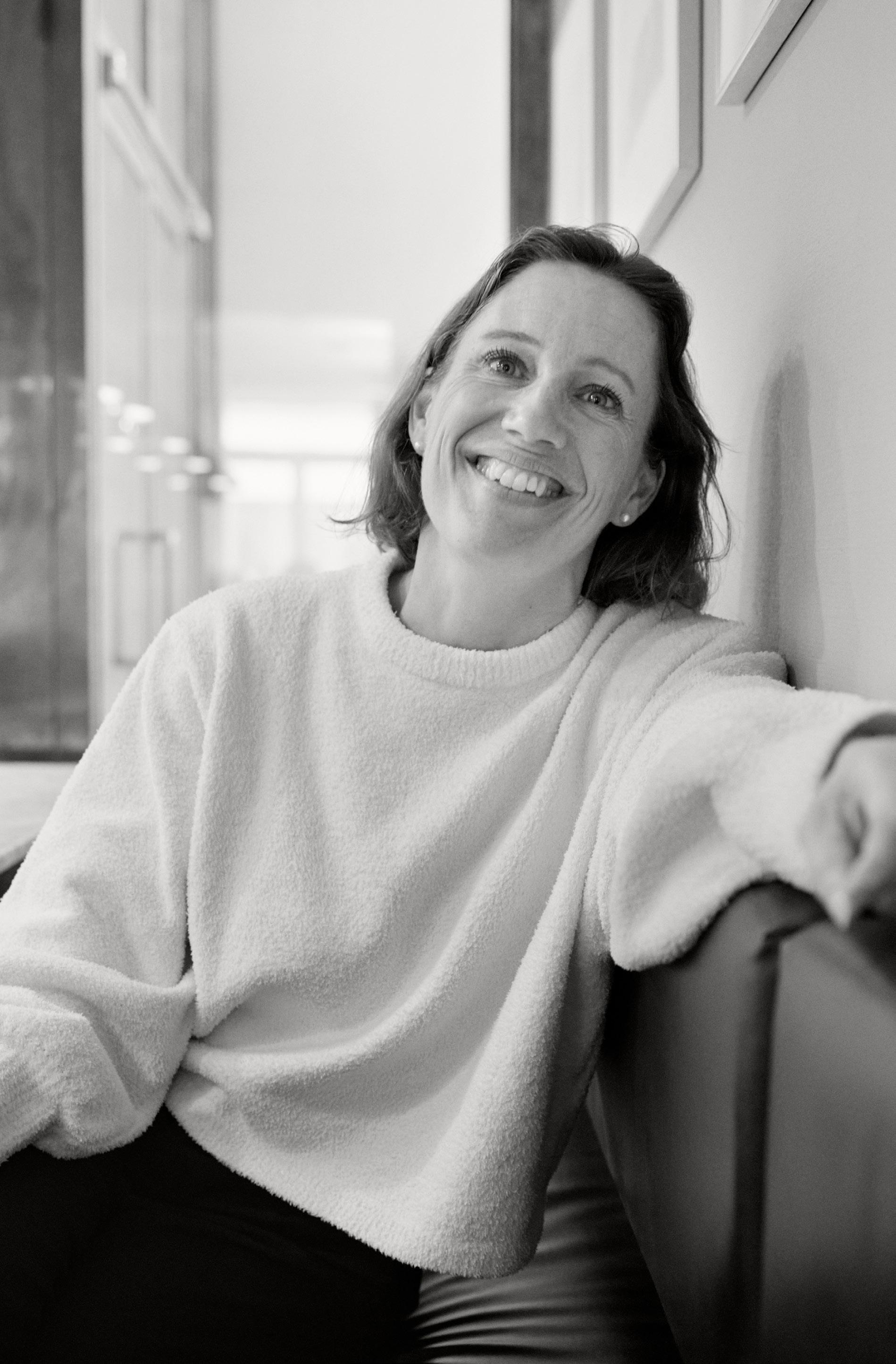
Malin Crona hopes that the business sector will also contribute through committed employees. “Here I’m thinking of perhaps mentoring or similar. I think that’s necessary if we are to create pathways to the job market.”
63
 Police officers Johan Sone and Catharina Törnqvist.
Police officers Johan Sone and Catharina Törnqvist.
JOHAN SONE
“I believe that these children and young people have so little opportunity that the power of the business sector is needed for this work to succeed. It’s not the police and social services that will solve the situation, but Swedish society that will ultimately do so.”
65
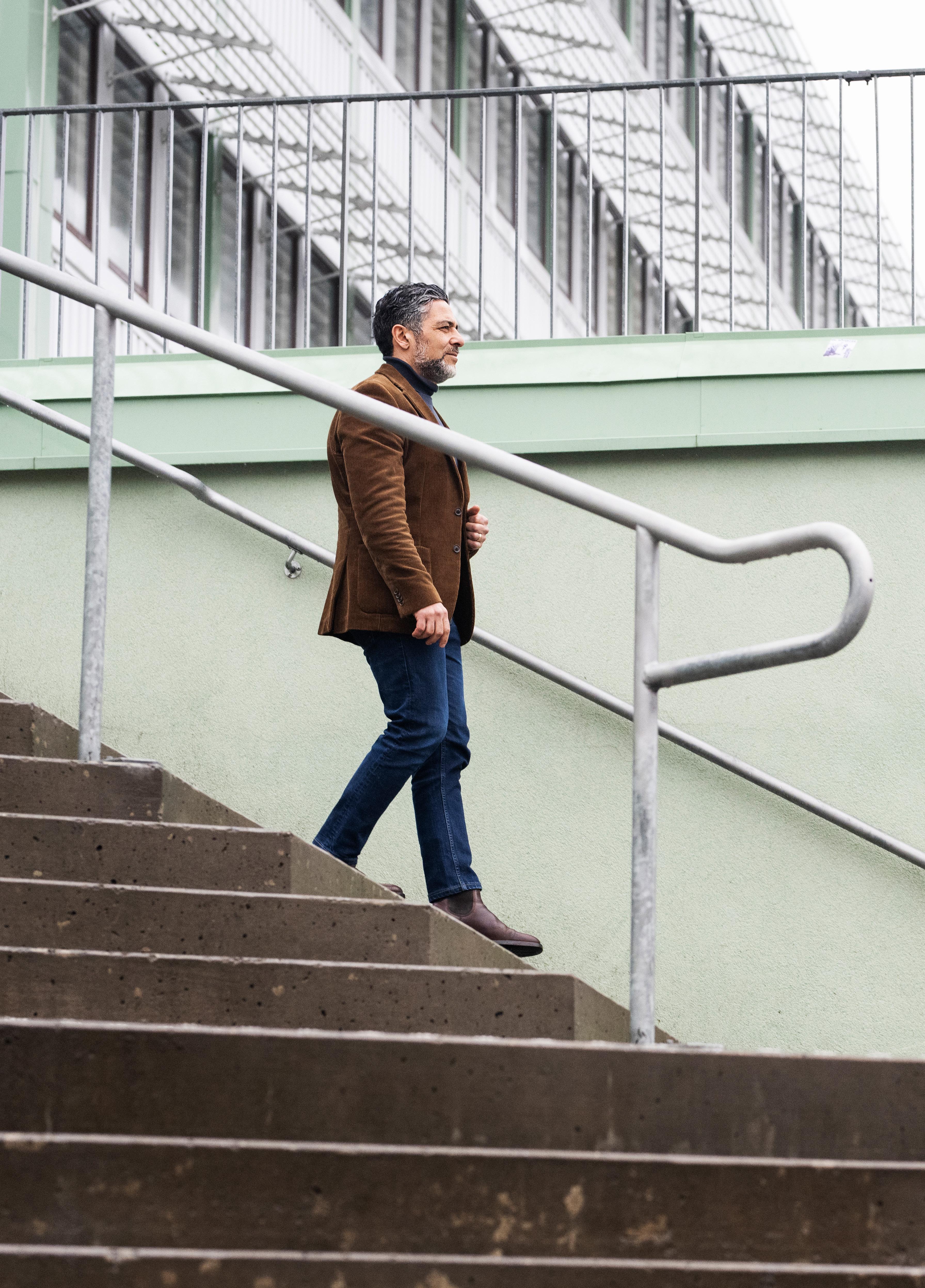 Alessandro Rezaei, department head at social services for Gothenburg Northeast.
Alessandro Rezaei, department head at social services for Gothenburg Northeast.

When the police and social services agree, the family is contacted by specially selected police officers known for their strong communication skills.
“It’s important that the right people make the first visit, so that the message that it’s an offer comes across clearly,” says Catharina Törnqvist, continuing:
“By building trust we can make it clear that it’s voluntary, and the goal is to show that we want to help the family and build trust in society.”
Social services contribute by assessing the family’s needs.
“The approach also gets schools involved in a completely different way to before, which is important,” says Alessandro Rezaei.
The business sector enters the process last, once the children have been identified and social services have mapped out the needs of the child and family. The needs that the municipality cannot support on its own are forwarded to the Skill Shift Initiative.
“It’s important to show that we believe in the family and that this is something we are doing to support them.”
“That’s where our contribution comes in – for example, if someone needs membership of a ju-jitsu club so that they have a meaningful way to spend their leisure time,” says Malin Crona.
Support can also involve helping parents find employment.
“For example, one parent wanted to change jobs because they had a very long commute. In this situation we can contact employers through our networks. It might also involve summer jobs for the child’s older siblings, or internships,” she says, continuing:
“Then there are many organisations that already have good activities, such as tutoring or parent support programmes. The idea is that we are a link to them as well. Sometimes the support is free, sometimes it may need to be financed.”
Alessandro Rezaei adds:
“It’s a toolbox that social services don’t always have access to on their own.”
All the parties consider it crucial for public and private sectors to collaborate. Johan Sone highlights increased polarisation in Swedish society, with some children achieving poorer school results and becoming increasingly distant from the job market.
“It creates a perfect storm in which organised crime can easily and quickly recruit children into a
world where status becomes readily accessible,” he says, emphasising the importance of finding pathways into established society.
“I believe that these children and young people have so little opportunity that the power of the business sector is needed for this work to succeed. It’s not the police and social services that will solve the situation, but Swedish society that will ultimately do so,” he says.
Malin Crona agrees that more people need to get involved.
“From the companies’ perspective, it is a case of both social responsibility and self-interest – the spiral we’re in now is bad for Sweden, but also bad for employers and geographically in the areas where they operate. Companies generally want to help, but there isn’t always a platform to do so – and that is what this provides,” she says.
For the project to succeed, all the pieces need to be in place. Catharina Törnqvist points out that the police must select the right children for the intervention, but that the approach of the police officers who first meet the family is also crucial.
“It’s important to show that we believe in the family and that this is something we are doing to support them. It’s also a huge job for the dedicated family therapists who work on motivating the child and family to want to change the direction of their lives,” she says.
Malin Crona emphasises her hope that the business sector will contribute not just financially but also through committed employees.
“All the research shows that if you can catch children who are heading in the wrong direction early and implement powerful interventions, it’s a good deal economically for society.”
“Here I’m thinking of perhaps mentoring or similar. I think that’s necessary if we are to create pathways to the job market,” she says.
Alessandro Rezaei stresses the importance of persevering with support for the parents.
“There will come a point where the parents need to continue working with these children on their own. We’re there for a period, but they won’t always be in Rätt Kurva. We need to strengthen the parents in this process of change,” he says.
68
Johan Sone adds:
“Long-term commitment will increase trust in the local police and social services, so that is another success factor. Knowing that Rätt Kurva is there for the duration and can offer support to more families. I believe success depends on our ability to be long-term in this work – we won’t see the results of this work until perhaps 15-20 years from now,” he says.
The four also highlight the importance of support from the Erling-Persson Foundation, as summed up by Malin Crona:
“It means so much, not least because it involves three-year support throughout the pilot project, which is incredibly valuable. Being able to say that the Erling-Persson Foundation is involved in financing the project also gives us a good reputation and serves as a quality stamp,” she says.
Catharina Törnqvist mentions that they have made preparations for evaluating how the intervention works in Sweden over time, as was previously done in Germany.
“There it was seen that 40 percent of the children who participated in the project completely stopped committing crimes, for example. Here we need to involve more families before we can make any quantitative analyses,” she says.
Initially the pilot project will be evaluated in collaboration with researchers at the University of Gothenburg. One question will be how effective the families themselves, schools and social services find the work to be.
Johan Sone concludes: “All the research shows that if you can catch children who are heading in the wrong direction early and implement powerful interventions, it’s a good deal economically for society. A Rätt Kurva intervention could cost around SEK 500,000 over a couple of years, but a child falling into crime costs society far more than SEK 20 million. Having said that, it’s the child themselves who pays the highest price.”
3
The number of children at risk of being socialised into crime – every day.
20
SEK 20 million is a conservative estimate of the cost to society over a lifetime for a child who ends up in crime.
ABOUT THE PROJECT
40%
This large percentage of children in a German study on the Rätt Kurva method completely stopped committing crimes. The remaining 60 percent reduced their criminality by at least half.
Project leads: Johan Sone, Catharina Törnqvist, Alessandro Rezaei and Malin Crona.
Title: Rätt Kurva (On the right track).
What it involves: The project was initiated by the police, inspired by a German collaborative model. The police select families they believe have children at risk and coordinate with social services. Everything is on a voluntary basis, and the family receives a family therapist who can guide them to the right kind of help. From the business sector’s part – with the Skill Shift Initiative serving as a hub – the contribution is partly financial and partly, through networks, offering things like internships, summer job placements, jobs and mentoring. In the first year 30 children and their families in Gothenburg, Linköping and Södertälje will be included in the programme. The goal is that within three years 100 families will start in the programme.
Funding: The Erling-Persson Foundation is supporting the project with SEK 3 million over three years.
69
SEK 10 M / 3 YEARS
TARGETED SUPPORT FOR YOUNG PEOPLE AND FAMILIES IN NEED
SOS Children’s Villages aims to work preventively in two projects to strengthen people’s protective factors. In one project, young people leaving social care are given a dedicated contact person who can provide them with support in their transition to adulthood. In the other, parents in particularly vulnerable families are supported in strengthening their parenting skills.
Around 25,000 children are placed in social care each year in Sweden. But when these young people turn 18, everything changes overnight. Hanna-Liisa Juntti, a social worker and team leader at SOS Children’s Villages’ national unit, previously worked in social services.
“I encountered this target group and it was hugely frustrating to see what happened when they turned 18. Then those of us at social services stand aside and say goodbye, good luck... Sometimes young people would call me up and say ‘I used to long to turn 18, but I don’t want to be 18 anymore,’” she says.
Her colleague, social worker and programme developer Synnöve Corson, adds:
“As a group they have an increased risk of suicide, poor mental health, unemployment and homelessness. It’s terribly distressing for these young adults. But we also know that only 35 percent of our target group graduate from high school, and that’s such a loss to society,” she says.
“You have to be allowed try and fail, and you need a fixed contact point like the youth programme or a support person.”
Finding placements can be difficult, with some youngsters having to move, change schools and join a new family multiple times.
“Alongside this, the young people need to catch up
on what they didn’t get to start with and prepare for a future that is tougher than for others,” says HannaLiisa Juntti, with Synnöve Corson adding:
“I think you sum it up pretty well. You have to make the move into adult life earlier than your peers, with fewer resources in your account and all on your own.”
She clarifies that the resources they are talking about here are emotional, practical and knowledgebased as well as material. The support programme started in 2019 and now includes 80 young people each year.
“Becoming an adult is a tangled journey. You have to be allowed to try and fail, and you need a fixed contact point like the youth programme or a support person. There are many good support initiatives in the community, but here we take a holistic approach and act as bridge builders,” she says.
Together with the young person they develop an action plan covering 12 months, during which the youngster has meetings with their support person on a weekly basis.
They explain that placements can vary – one person may have to move 30 times, while another has always lived with their aunt. As a result, the things that the young people need to work on differ – making it important to match them with the right support person.
“The majority are social workers or similar, but there are also teachers, psychologists, nurses and people with completely different careers – because we’ve seen this that also works,” says Synnöve Corson.
70

The young people have different things they need to work on, such as studies. Synnöve Corson highlights the importance of targeted support: “You have to make the move into adult life earlier than your peers, with fewer resources in your account and all on your own.”.
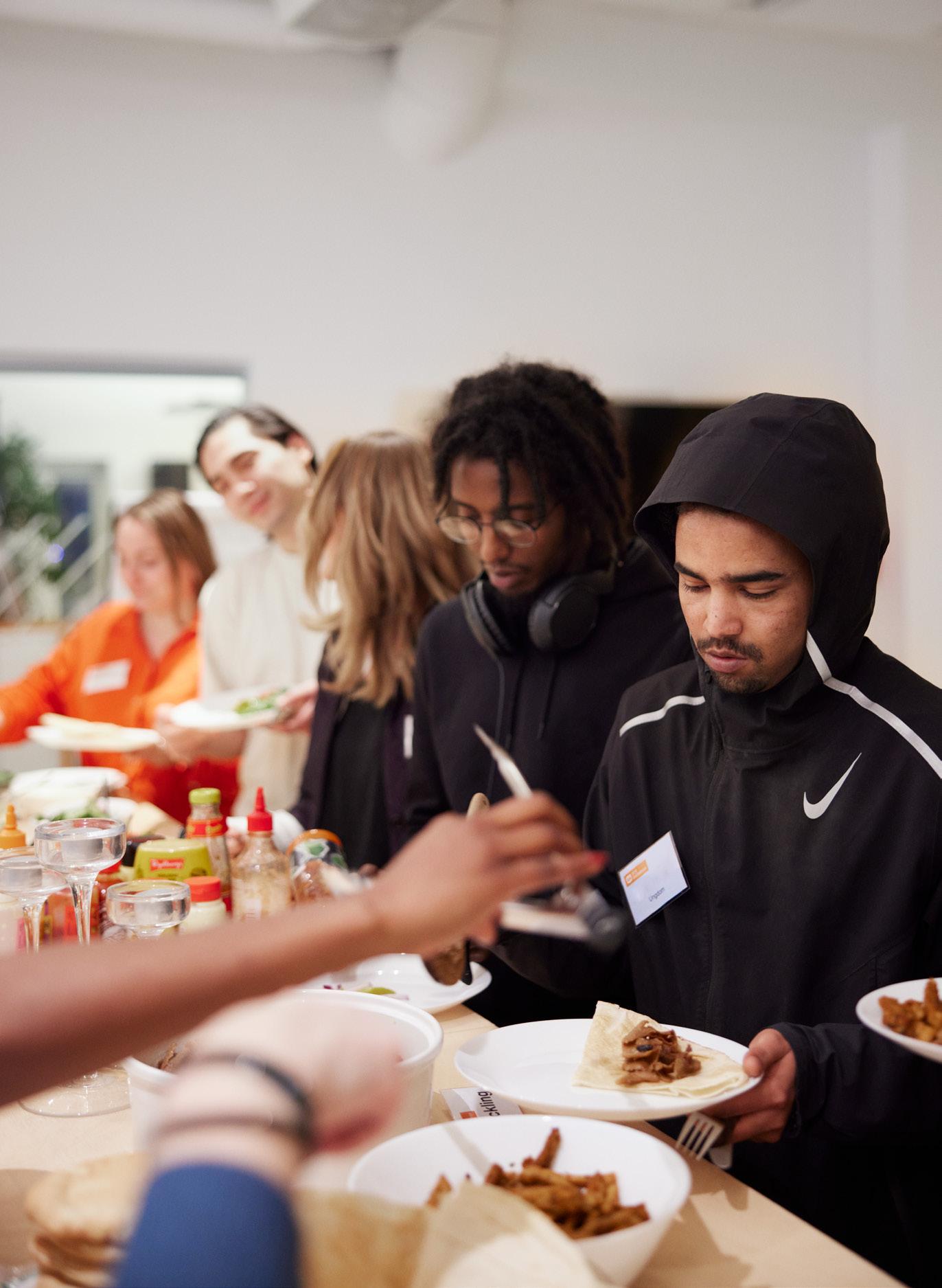
One day a week there is an open house where people eat together as a break from homework. This is appreciated because the young people may have poor finances, but also sometimes feel lonely.
72
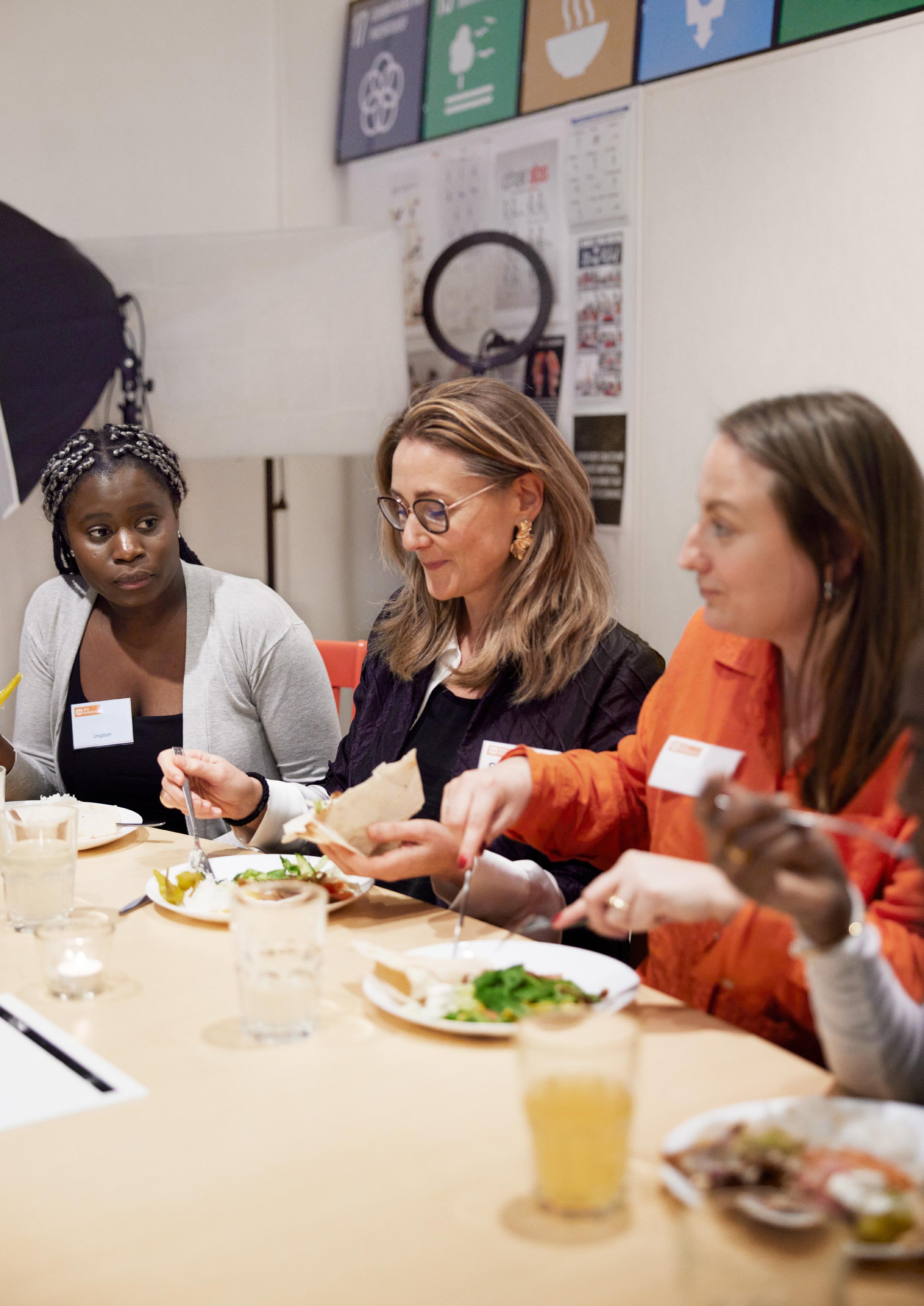 Synnöve Corson, centre, and Hanna-Liisa Juntti on the right.
Synnöve Corson, centre, and Hanna-Liisa Juntti on the right.

74
Ebrahim is a participant in the youth programme and a member of SOS Children’s Villages’ youth council. Katja Enzell works as a coordinator in the programme.
The action plan covers four areas of life – health, housing, work and studies – as well as networks and connections. It could involve help in accessing the necessary care, practical things like paying bills or encouraging the person to get some training or education even if they didn’t find school easy.
“Then there’s the opportunity to join in with our open group activities, which offer homework help and simple support for things that maybe can’t wait to be dealt with by their support person. We also have themed groups – for example, now is the time to start thinking about summer jobs – and we also have things like a course in driving theory,” lists Hanna-Liisa Juntti as examples.
Throughout the year there is ongoing follow-up to ensure they are working according to the action plan, meeting their support person and that they have relevant goals. At the end of the 12 months a review is carried out.
“The project is based on the idea of a one-year time period, and our goal is that once that year is over, you should feel ready. But people move on at different times; we have revolving doors that are never tightly shut, and people are always welcome – at our open Wednesdays, for example. The attitude is ‘get in touch when something happens in life and we’ll see what we do’,” says Hanna-Liisa Juntti.
The support from the Erling-Persson Foundation will allow the 80 young people enrolled to be expanded by 25, but this doesn’t meet the need that exists.
“Our long-term goal is for social services to take full financial responsibility, whether it’s us doing it or someone else taking this holistic approach to the young people’s lives,” says Synnöve Corson.
The other project involves activities to strengthen families. Both projects are based on the programme for unaccompanied minors that was started by SOS Children’s Villages and received support from the Erling-Persson Foundation in 2016.
“We saw that there was a great need when their parents and siblings arrived through family reunification – how a very promising start to integration just completely halted. The young people had to take full responsibility for their parents and siblings, dropping out of school to take extra jobs to support everyone, finding an apartment, taking siblings to school, interpreting – all of those things. That’s when we started this family-strengthening project,” says Hanna-Liisa Juntti.
It operates in Gothenburg and Stockholm, supporting newly arrived families, but now aims to broaden its scope to encompass a wider target group.
“We’re facing major challenges in Swedish society in terms of exclusion and crime. It’s basically about parents and children facing many risk factors, but there’s a huge amount we can do to strengthen protective factors,” says Synnöve Corson.
About 500,000 children grow up in vulnerable families in Sweden, a quarter of all children. Within the programme families can access various individually tailored services to strengthen their protective factors, resilience and self-confidence. Support can include practical everyday support, education, knowledge-building initiatives, work-related interventions, school holiday activities, study visits, or social and educational activities. They both feel that there is a great deal to be done together with the parents and children.
“We have revolving doors that are never tightly shut, and people are always welcome.”
“That’s why we need to step in. The idea is to explore and build up the programme during 2024 and then test it. We already know that we have a model that is applicable to many different groups and from many different perspectives, but we need to look at where we are needed now. And then in the second year we’ll go live,” says Synnöve Corson.
She describes how in both the young people’s programme and the parent programme, both young people and parents need the secure and stable focal point of a fixed support person who can navigate and help make all the support available in society accessible and build trust in these networks.
“This parental strengthening is also important preventive work to avoid young people getting into trouble later on,” says Synnöve Corson.
The qualified support persons used in both programmes are employees, not volunteers. The point of this is that with employment comes responsibility and a clear commitment. This is what is needed when support persons are to work individually based on a structured plan over time.
“Then we also work on education, we provide guidance and review how things are going. It’s part of the mission and we sign year-long contracts with people who are employed on an hourly basis as needed. When the support person receives an assignment we formalise what it entails, for how long a period and how many hours it will take,” says Hanna-Liisa Juntti.
75
So what does the support from the Erling-Persson Foundation mean?
“For the youth programme, it means continuing to enable something that produces results and for which we currently have a waiting list and demand. Being able to continue to put this in place and implement a new way of working, especially in relation to social services. But it takes time, so we want to be able to take that time and have the opportunity to help more people,” says Hanna-Liisa Juntti, with Synnöve
Corson adding:
“And when it comes to the family project, it’s a lot about taking the next step and meeting the needs and challenges that society faces right now. It’s a very exciting journey that we’re embarking on together with the Erling-Persson Foundation, where we want to broaden the family-strengthening work we’ve already started for part of the target group. Now we will be able to step forward and meet the needs of more children who are vulnerable.”
‘PÅ EGNA BEN’ PODCAST
For those who want to know more there is the podcast series ‘På egna ben’ (On their own feet). In five 20-minute episodes young people talk about their experiences of social care. You can find ‘På egna ben’ on your podcast app.
25,000
The number of children placed in social care each year in Sweden. Social care refers to placements in emergency accommodation, foster care, an institution or supported housing.
500,000
The number of children in Sweden estimated to grow up in vulnerable families, representing a quarter of all children. These include families struggling with issues such as addiction, violence and mental health issues, single parents with little education or with neurodevelopmental disorders, and exclusion due to migration.
ABOUT THE PROJECT
12–15
The estimated cost to society over a lifetime for a person who never enters employment is SEK 12–15 million.
Project leads: Synnöve Corson and Hanna-Liisa Juntti.
Title: Kraftsamling mot utanförskap i Sverige (Joint efforts to counter exclusion in Sweden).
What it involves: By offering mentors to young people leaving social care and help to families where the adults need support in parenting, the aim is to reduce exclusion in Sweden over time.
Funding: The Erling-Persson Foundation is supporting the project with SEK 10 million over three years.
76
NEXTGEN SOLUTIONS
Fryshuset
SEK 20 M / 3 YEARS
For all young people – regardless of background – to have the same opportunity to establish themselves in society, young people living in socioeconomically disadvantaged areas need help with developing their entrepreneurial skills. In NextGen Solutions, Fryshuset wants to create a place where there is a low threshold for young people to develop their entrepreneurial skills, ideas and passions.
The project helps young people to better meet the demands of today’s job market while harnessing and conceptualising young people’s ideas through entrepreneurial mentoring. Harnessing the innovative power of young people also helps to increase the diversity of society’s entrepreneurs and employers while simultaneously developing our suburbs.
VÄRMEVERKET
Stiftelsen Värmeverket
SEK 20 M / 2 YEARS
At present there is a disconnect between creative ideas and their potential market. At Värmeverket in the Stockholm suburb of Bredäng young people are given the chance to enrol on a ‘Creative Foundation Year’ and also to test their solutions in the market as part of a grantfinanced programme. A range of activities are allowing more young people to take the step from creator to entrepreneur.
Värmeverket’s mission is to create inclusive and creative environments and to offer programmes that encourage education, entrepreneurship and culture with a focus on strengthening the local area as well as the individual. The focus is on giving people the conditions in which to develop their talents as well as themselves. Värmeverket builds on creation and interaction in knowledge and culture. Entrepreneurship can help strengthen social integration within the creative industries. By offering multiple creative spaces, they want to make resources and conditions available that do not exist today.
THAT COULD HAVE BEEN US – TRAVELLING EXHIBITION
Glada Hudik Theatre
SEK 6 M / 3 YEARS
Glada Hudik Theatre’s film ‘Det kunde varit vi’ (It could have been us) premiered in spring 2024 and depicts a time in Swedish history when experiments were carried out on people with intellectual disabilities. The film’s background material will be used for a travelling exhibition, supplemented with teaching material for young people aged 14 to 19.
To understand our present, we must try to understand our history. Analysis company Ungdomsbarometern (Youth Barometer) has reported that fewer and fewer young people are interested in social policy. Glada Hudik Theatre wants to contribute to young people’s conversations and awaken their desire to be involved in developing a more inclusive society. The travelling exhibition will be created to evoke emotions, thoughts and engagement.
MENTOR
Mentor Sweden
SEK 1 M / 1 YEAR
Mentor Sweden is a non-profit organisation that offers mentoring programmes for young people aged from 13 to 17 years. The programme aims to strengthen young people’s self-esteem and belief in the future as well as to expand their social networks, in order to support them in choosing a healthy and drug free lifestyle. Mentor’s core activities consist of mentoring programmes for young people aged from 13 to 17 years.
Mentor Programme – a structured individual programme lasting six months, in which young people are given their own adult mentor.
Mentor Boost – a half-day activity in which coaches from Mentor’s partner companies talk about their work.
Mentor Inspo – inspiration and school motivation for future career choices. A digital presentation gives young people personal stories about career choices and routes taken to get there.
OTHER DONATIONS 77
EN DAG FÖR ATT ORKA FLERA
Min Stora Dag
SEK 2 M / 2 YEARS
Min Stora Dag (My Special Day) works to give joy to children with serious illnesses and diagnoses. The concept is all about making the children’s dreams come true. On their special day the child gets to experience something they have dreamed of doing or gets to meet someone they admire, or to have fun with others who know what it is like to be in their situation.
The project “En dag för att orka flera” (One day to give you strength for more) aims to bring strength, joy and hope to children, but also to have a positive impact on entire families and our society. Healthcare professionals across the country where children and young people receive care help Min Stora Dag to reach its target group.
CLOWNMEDICIN OPERATIONAL SUPPORT
Clownmedicin
SEK 780,000 / 1 YEAR
Since 1998 Clownmedicin (Clown Medicine) has been visiting children and their families at Astrid Lindgren Children’s Hospital. Clowns are at the hospital in Solna six days a week and in Huddinge three days a week, for 50 weeks of the year. In total nearly 30,000 children who have been admitted to hospital and their relatives are visited by the clowns every year.
The clowning has a real purpose – to make the hospital stay easier for the whole family, but also when necessary to make the work of the hospital staff easier so that the treatments go as smoothly as possible. The clowns provide a complete distraction from sickness and medication. A visit from a clown can act as a stress-relieving safety valve, giving the family ‘a breath of fresh air’ and distracting their thoughts for a while from things that are frightening and worrying.
OTHER DONATIONS 78
YLVA LINDERSON
“The projects in the stories that we get to be involved in have very different purposes, but what they all have in common is that they are driven by individuals who are extremely knowledgeable in their field and who have strong convictions and a desire to improve people’s lives.
As a result, it feels like there are things in our world that are actually moving in the right direction.”
79
BOARD OF DIRECTORS
FROM LEFT:
MATHIAS UHLÉN
Board member. Born 1954.
Mathias has an MSc in chemical engineering and a PhD from KTH Royal Institute of Technology. From 1999 to 2001 he was Vice President of KTH. Mathias is a member of the Royal Swedish Academy of Sciences and the Royal Swedish Academy of Engineering Sciences (IVA), as well as the National Academy of Engineering in the USA.
Since 1998 Mathias has been professor of microbiology at KTH, from 2012 to 2021 he was professor of biotechnology at the Technical University of Denmark (DTU) and since 2018 he has been visiting professor of neuroscience at Karolinska Institutet. He was director of the Science for Life Laboratory from 2010 to 2015 and has worked for industrial applications of the research through various corporate collaborations and entrepreneurial ventures. Mathias’ research on protein A is the basis for the export success of MabSelect SuRe, among other things.
Mathias co-founded the biotech companies Pyrosequencing AB, Affibody AB and Atlas Antibodies AB, among others, and is an advisor to the venture capital fund Healthcap.
CHARLOTTE SÖDERSTRÖM
Board member. Born 1977.
Charlotte studied market economics at Institutet för Internationell Utbildning (IIU). Up until the age of 21 she was an active competition rider in equestrian sport and today she runs the Stuteri Arch stud farm in Skåne in southern Sweden. The stud farm breeds, trains and sells jumping horses and in 2019 and 2021 the International Federation for Equestrian Sports (Fédération Equestre Internationale – FEI) named her as its Owner of the Year. Charlotte is also involved in the sponsorship project H&M We Love Horses as well as apparel brand All In Equestrian.
Board member at family companies and of Haga Gårdsförvaltning.
TOM PERSSON Board member. Born 1985.
From 2006 to 2010 Tom studied at the European Business School and Metropolitan Film School in London. He subsequently worked on the production and financing of TV and film projects.
Since 2016 Tom has run investment company CoMade, which focuses on the media sector. Alongside his own company he works with around 10 other companies in film, television and sound.
Board member at family companies and other companies including Breakable Films AB, Third Ear Studios AB, Playpilot AB, Art & Bob AB and Naudio AB.
ELISABETH TAMM
Board member. Born 1947.
Elisabeth has degrees in law and business administration from Uppsala University. After a period as a notary she was employed at the Swedish Tax Agency in Stockholm. She has also been head of tax and family law at Carnegie and Ålandsbanken.
Elisabeth chairs or holds other positions of responsibility at a number of foundations, including the Alba Langenskiöld Foundation associated with publishing house Langenskiöld, the Foundation for the Astrid Lindgren Children’s Hospital, the Tranås Säteri Foundation and Sällskapet för Makarna Malmqvists minne.
STEFAN PERSSON
Chair of the Board. Born 1947.
1969–1973 Stockholm University and Lund University. 1976–1982 Country Manager for H&M in the UK and responsible for H&M’s expansion abroad.
1982–1998 President and CEO of H&M.
1998–2020 Chair of the Board at H&M.
Other board positions at family companies.
MARI-ANNE CRONSIOE OREFORS
Board member. Born 1957.
Mari-Anne has a degree in economics from Stockholm University. After graduating she worked for five years in H&M’s buying department. From 1985 to 2020 MariAnne had a key role at the Ramsbury family office as accounts and administrative manager. Mari-Anne was involved in setting up the Erling-Persson Foundation and has also been part of the H&M Foundation since it was established in 2007.
Mari-Anne is on the board of the H&M Foundation and has been responsible for running the accounting and administrative side of the foundation during its first 20 years.
80
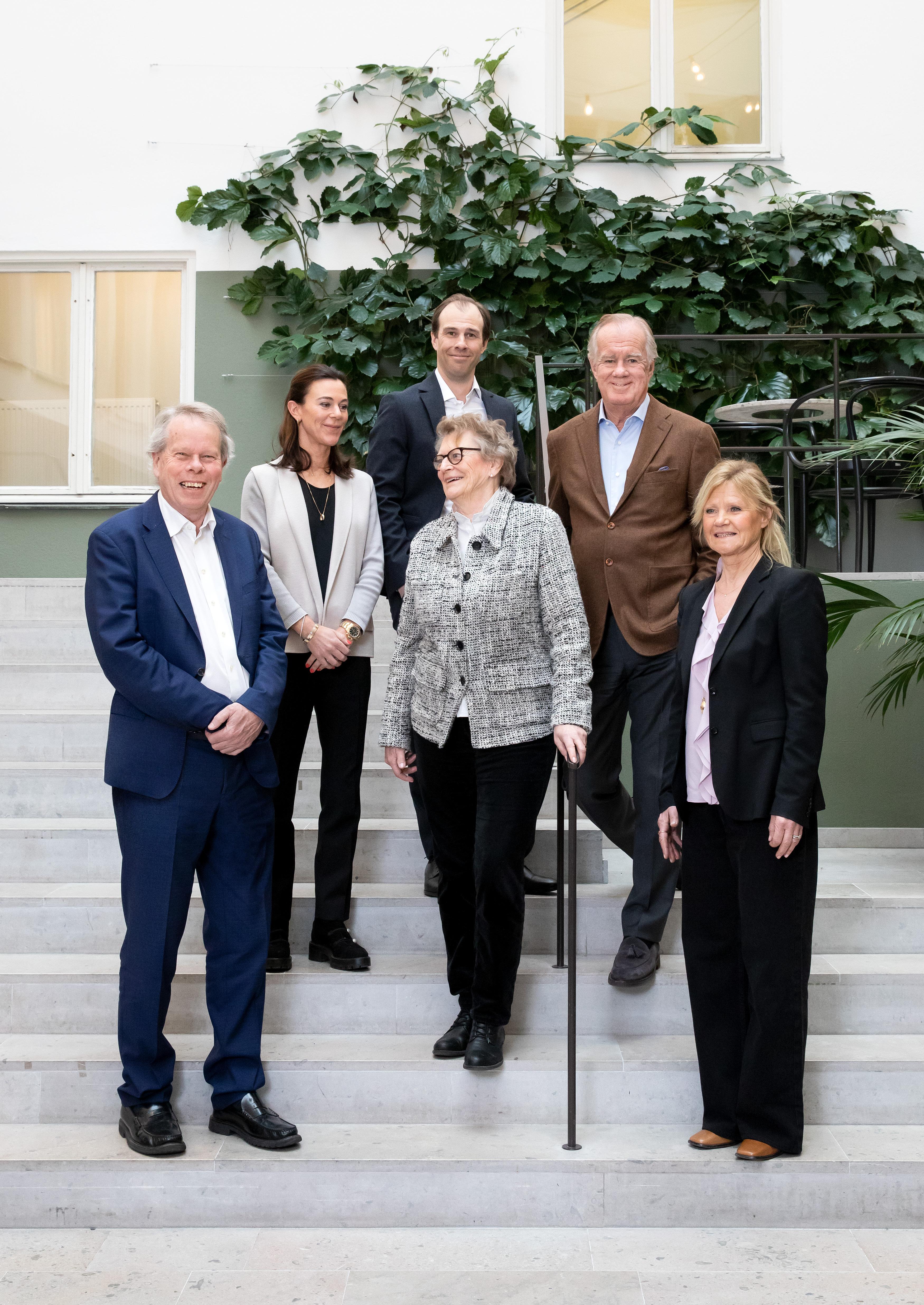
GRANTS AWARDED
The Erling-Persson Foundation
& RESEARCH
KTH Royal Institute of Technology, Joakim Lundeberg
University of Gothenburg, Joan Camuñas-Soler
Karolinska Institutet, Anders Kvanta
University of Gothenburg, Jonas Nilsson
Linköping University, Edwin Jager
Karolinska Institutet, Agneta Richter-Dahlfors
Umeå University, Maréne Landström
Institutet, Thomas Helleday
Uppsala University, Tobias Sjöblom
Uppsala University, Marika Nestor
SLU – Swedish University of Agricultural Sciences, IUFRO World Congress 2024
& EDUCATION
DEVELOPMENT OF CHILDREN & YOUNG PEOPLE
Stockholm School of Economics, Professorship in Youth Leadership
Stockholm School of Economics, House of Innovation
Företagsamhet)
3
SCIENCE
TOTAL SEK TERM
65.5 m 5 years
15 m
years
5
10 m
years
3
10 m
3 years
m
6
3 years
6 m
years
6 m 3 years Karolinska
6 m 3 years
6 m 3 years
2 m
year
Fryshuset 20 m 3 years Värmeverket 20 m 2 years Glada Hudik Theatre 6 m 3 years Skill Shift Initiative (Beredskapslyftet)/Rätt
3 m 3 years SOS Children’s Villages Sweden 10 m 3 years Mentor 1 m 1 year Min Stora Dag 2 m 2 years Clownmedicin 0.8 m 1 year
3
6 m
years
1
TUITION
Kurva
15 m
year
467
5 m
years Young Academy of Sweden 11 m 5 years Skill Shift
2 m 1 year
8.1 m 3 years Stockholm
60 m 5 years
1
m 10 years Hanken School of Economics
3
Initiative (Beredskapslyftet)/Reskilling Ukraine
Junior Achievement Sweden (Ung
School of Entrepreneurship
2023 82
FINANCIAL STATEMENTS
The Erling-Persson Foundation
*Refers to grants awarded but not yet paid out
**Refers to amounts approved, gross
SEK M 2023 2022 INCOME STATEMENT 1 JAN–31 DEC Operating profit -6 -6 Income from securities 266 212 Interest income 22 6 Net profit for the year 282 212 ASSETS, 31 DEC Financial non-current assets 1,554 1,547 Current assets 461 459 Total assets 2,015 2,006 EQUITY AND LIABILITIES, 31 DEC Equity 502 972 Liabilities* 1,513 1,034 Total equity and liabilities 2,015 2,006 OTHER KEY FIGURES Grants awarded during the year** 770 1,007 Accumulated awards since 1999 5,376 4,625 Awards paid out during the year 255 503
2023
83
CONTACT
Ylva Linderson, Programme Manager ylva.linderson@erlingperssonsstiftelse.se
Kristina Stenvinkel, Communications stenvinkel@ramsbury.se
The Erling-Persson Foundation
Drottninggatan 50 Box 1421, SE-111 84 Stockholm, Sweden erlingperssonsstiftelse.se
©Erling-Perssons Stiftelse, 2024
Photos: Carl Hjelte, Emilia Bergmark-Jiménez, Ellika Henrikson, Scania Ukraine
Text: Lotta Fredholm
Graphic design and production: Open Studio
Printing and binding: Stibo Complete Typefaces: Brown Pro and Sabon
Paper: 300 g Gmund Colors Matt 03 and 150 g Munken Polar Rough
 Programme manager Ylva Linderson in conversation with Kristina Stenvinkel, who has responsibility for communications.
Programme manager Ylva Linderson in conversation with Kristina Stenvinkel, who has responsibility for communications.









 Fredrik Lanner and Anders Kvanta have been working together for over 10 years. Now they are starting a clinical trial to see whether their stem cells can help people whose vision is impaired as a result of dry macular degeneration.
Fredrik Lanner and Anders Kvanta have been working together for over 10 years. Now they are starting a clinical trial to see whether their stem cells can help people whose vision is impaired as a result of dry macular degeneration.

 From left: Yike Xie, Paolo Valentini, Joan Camuñas-Soler, Sandra Postic and Marta Gironella.
From left: Yike Xie, Paolo Valentini, Joan Camuñas-Soler, Sandra Postic and Marta Gironella.
 From left: Marta Gironella, Joan Camuñas-Soler, Sina Amirnezhad, Sandra Postic and Oliver Forsell.
From left: Marta Gironella, Joan Camuñas-Soler, Sina Amirnezhad, Sandra Postic and Oliver Forsell.






 Marika Nestor (left) highlights the role of her clinical colleagues Renske Altena, Rimma Axelsson and Jan Zedenius. “My role is reducing as we hand over more to those who have contact with the patients and can perform the imaging studies.”
Marika Nestor (left) highlights the role of her clinical colleagues Renske Altena, Rimma Axelsson and Jan Zedenius. “My role is reducing as we hand over more to those who have contact with the patients and can perform the imaging studies.”




 Magnus Mähring with Lee Malm, executive assistant at House of Innovation.
Magnus Mähring with Lee Malm, executive assistant at House of Innovation.







 Police officers Johan Sone and Catharina Törnqvist.
Police officers Johan Sone and Catharina Törnqvist.
 Alessandro Rezaei, department head at social services for Gothenburg Northeast.
Alessandro Rezaei, department head at social services for Gothenburg Northeast.



 Synnöve Corson, centre, and Hanna-Liisa Juntti on the right.
Synnöve Corson, centre, and Hanna-Liisa Juntti on the right.

